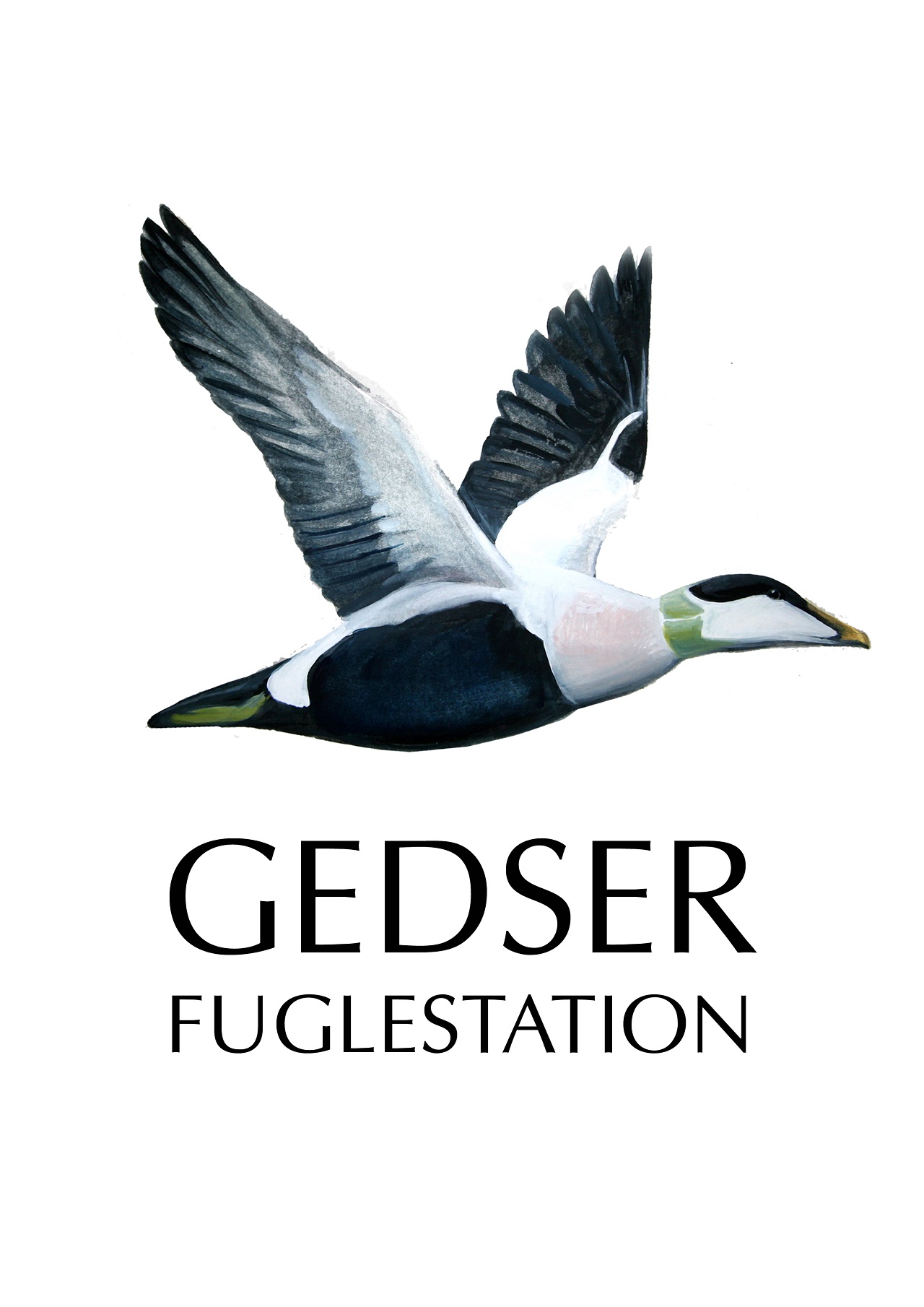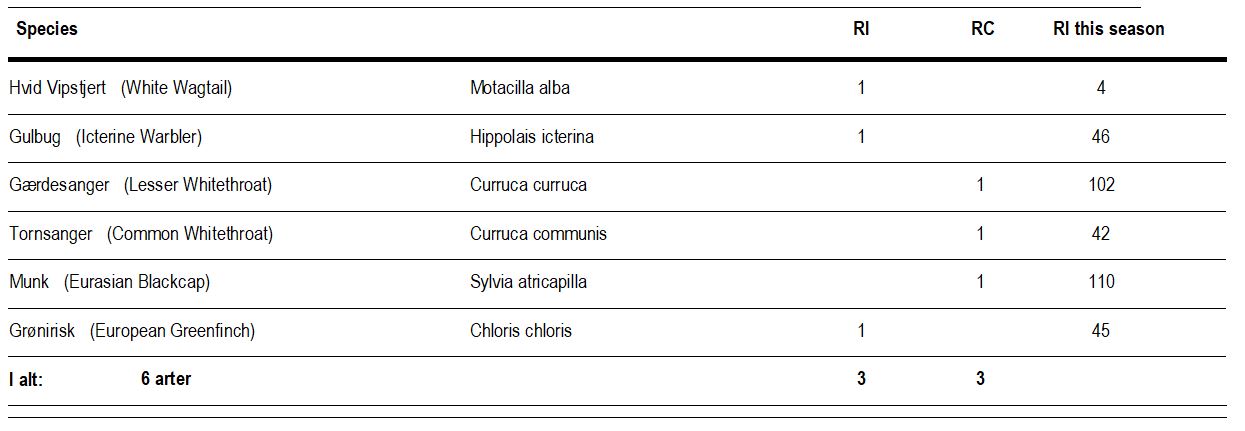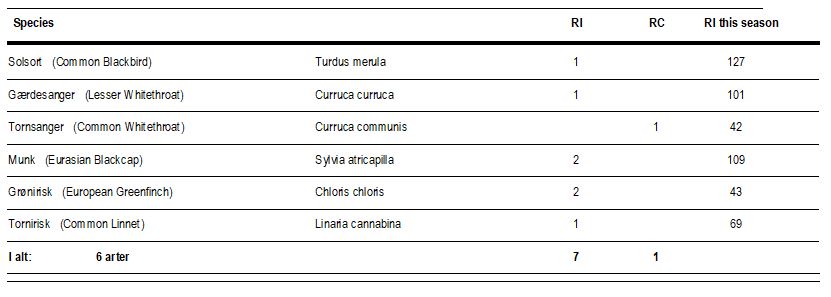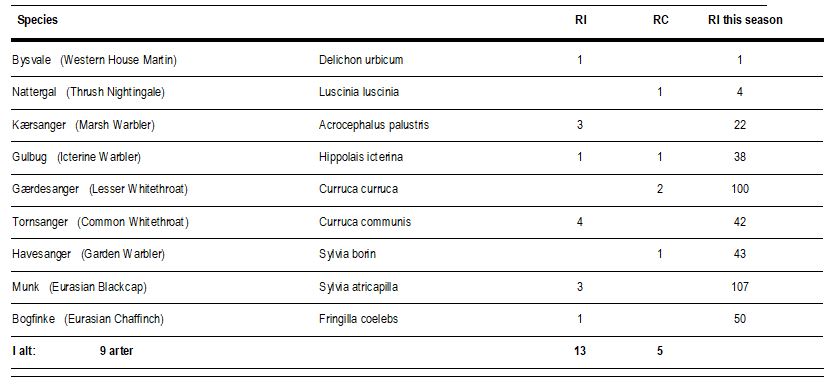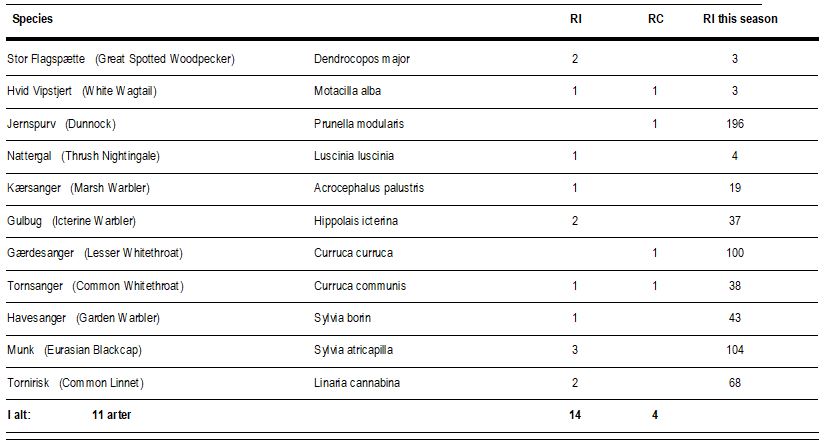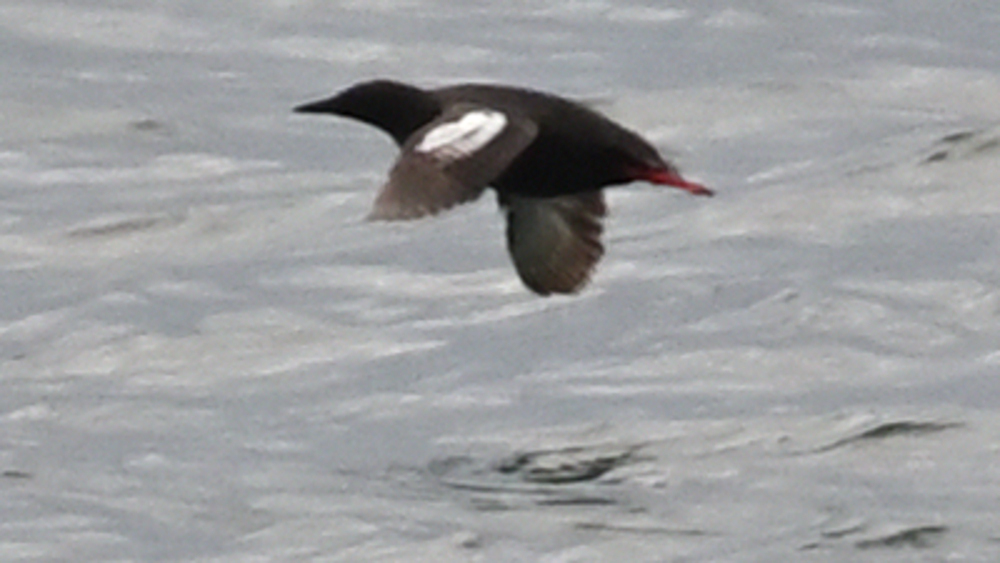Gedser Fuglestation Blog
Her på Gedser Fuglestations blog bringes korte nyheder i dagbogsformat om hændelser på fuglestationen.
Se indlæg fra måned: jan. (10)feb. (18)mar. (31)apr. (26)maj (31)juni (30)juli (23)aug. (31)sept. (30)okt. (31)nov. (30)dec. (20)
Crazy weather
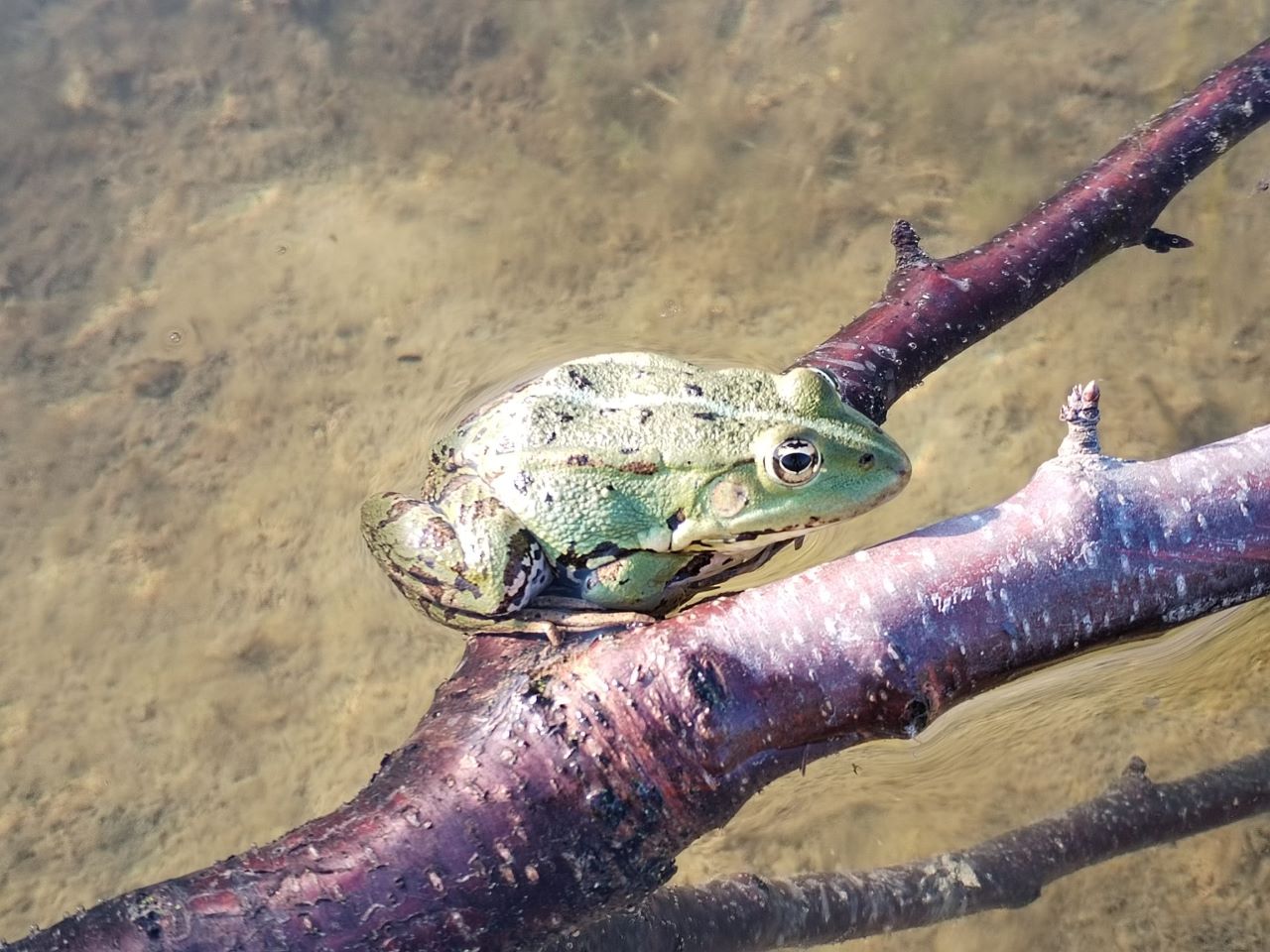
My conversation with the "weather frog" (Grøn frø - Pelophylax esculentus) at the pond yesterday evening did not help for today...
The weather forecast for this morning did not look well, already yesterday, when we checked the weather. But you never know, especially here, at the tip so close to the sea, the weather can change very fast and sometimes, the forecast can change within less then 20 minutes. So we had our alarms set. But honestly, we were not to sad, when we saw, that there was way to much rain for ringing, which would not stop for the next five hours. It is out of the season now, but still, we always did the five standard hours of ringing so far.
The rain meant, that we could go back to sleep and this was much appreciated, because yesterday evening, Henrik and I had exchanged the nets at the pond and in the end, it was quite late and there was still the blog to write… At this point, I need to apologise, the last moth in the list, A. lithoxylea was not caught at GFU but in Hans garden, the moth list was also done quite late, but I will update it with the right location now. Besides that, this rainy night, I didn´t have the light on, so no new moth for today.
For Henrik, it was the last day for this time, he left the station in the late morning, but will be back rather soon in August.
The ringing:
So a boring and quite day? No, later in the morning, I opened the nets, the weather looked fine outside and on the radar, but soon, a slight but constant drizzle began. I checked the radar and indeed, it showed this now, so I shut the nets down again, because in a while, it should stop for real and I could open again. After I had waited for a while, it was dry outside, the radar showed no rain at all for this afternoon and I opened again. I just had the nets open for 1.15 h, then, it started drizzling again. This time, the radar showed no rain at all. What a crazy weather! At the moment, it is a very sensitive time, temperatures are fine, so if 2k/ 3k+ birds get a little wet, but are extracted soon, we don´t need to worry, they won´t get cold and will be dry soon. But we are now also getting young birds, that just left the nest. They are much more sensitive and we do not want them to get wet. So I closed again. The 1.15 hours I could do were quite good, I caught 6 birds of six species, of which 3 were new and 3 recaps. The highlight was a White Wagtail “Hvid Vipstjert”, that I caught in one of the new nets at the pond!
People: Henrik Jørgensen, Hans Lind, Hanelie Sidhu
Wind, Sand and Stars
Ringmærkningen:
Vinden var ret hård da nettene skulle op, men alt kunne sættes op. Vinden lagde sig dog meget og det blev en ok dag(i forhold til de andre dage) og 9 fugle blev fanget hvoraf de 8 var nye.
I aften er det sidste dag for denne gang, men jeg ringmærker i morgen tidlig inden jeg tager hjem, men jeg er retur i august.
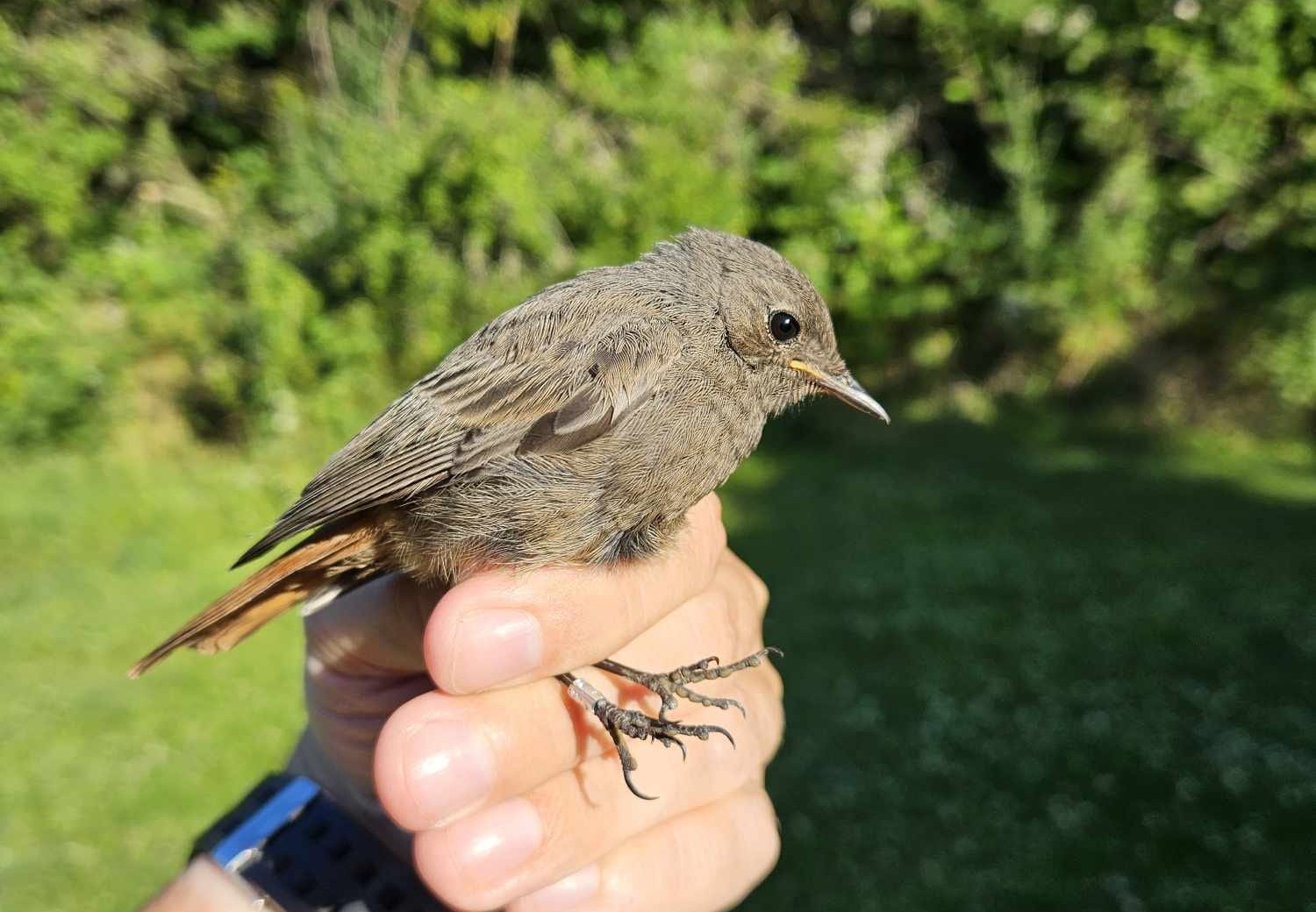
1K Husrødstjert - Black Redstart
Dagens ringmærkning og kontroller:
Hvid vipstjert/White wagtail 0/1
Husrødstjert/Black redstart 1/0
Gulbug/Icterine warbler 2/0
Gærdesanger/Lesser whitethroat 1/0
Munk/Blackcap 1/0
Gråspurv/House sparrow 1/0
Bogfinke/Chaffinch 1/0
Tornirisk/Linnet 1/0
Total 8/1
The moths:
The windy night did not make many moth fly. I got a new species for the season though, and also Hans in his garden. Pictures below.
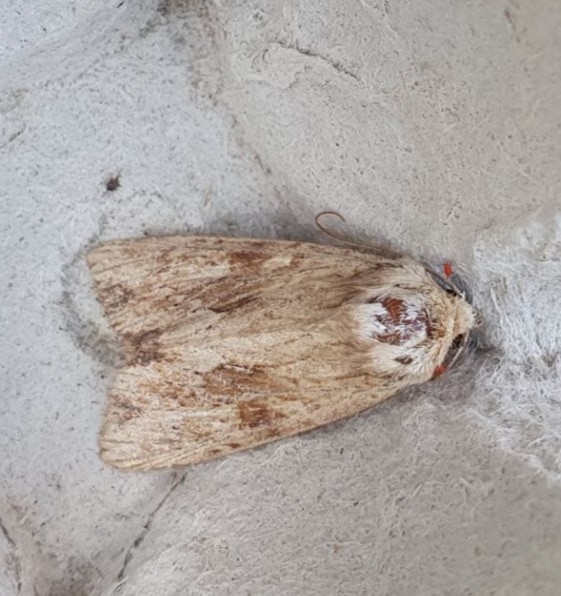
Apamea lithoxylea - Hvidlig stængelugle
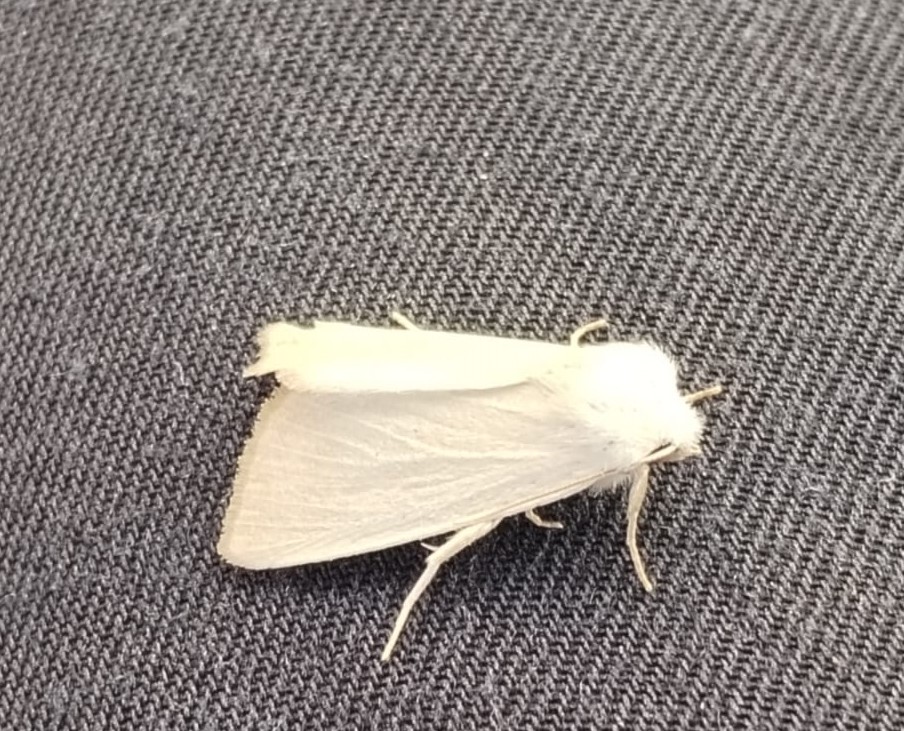
Arenostola phragmitidis - Tagrørugle
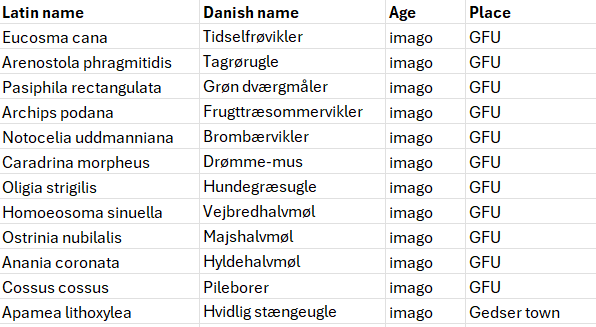
På stationen: Hanelie Sidhu, Henrik Jørgensen
Første unge gulbug
Ringmærkningen:
Efter gårdagens uvejr havde jeg regnet med at der var kommet en hel del vand, men vores måler viste kun kun at der var faldet 3mm her. Om sommeren har odden ofte den effekt at regnen går i opløsning ude over havet inden det rammer.
Fuglemæssigt var det endnu en tynd dag med kun 6 fugle hvor alle var nye.
Årets første unge af gulbug blev fanget og den kunne knapt flyve, så den blev ringmærket hurtigt og blev sluppet tæt på hvor den blev fanget.
Det var ret tryggende varmt til sidst under ringmærkningen og lige da alt var lukket begyndte det at dryppe lidt, men det var så også det. Det blev dog mere behageligt op ad dagen da vinden tog til.
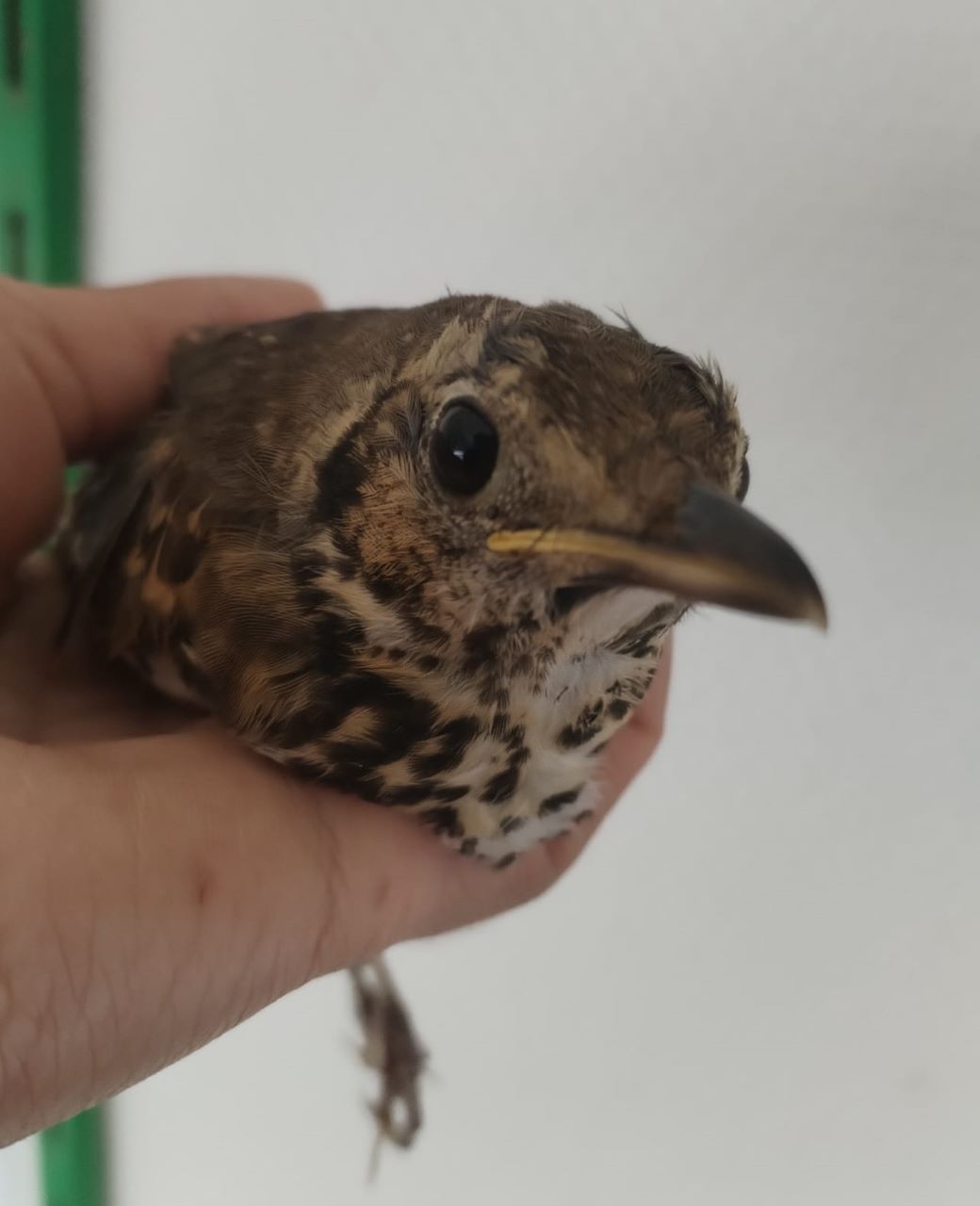
1K Sangdrossel - Song Thrush
Dagens ringmærkning:
Rødstjert/Redstart 1
Sangdrossel/Song thrush 1
Gulbug /Icterine warbler 4
Total 6
The moths:
Many moth were in the trap today, many of the familiar species that are in the trap every day now, but also new ones and quite some small ones, some of them could be identified, but others were a bit difficult…
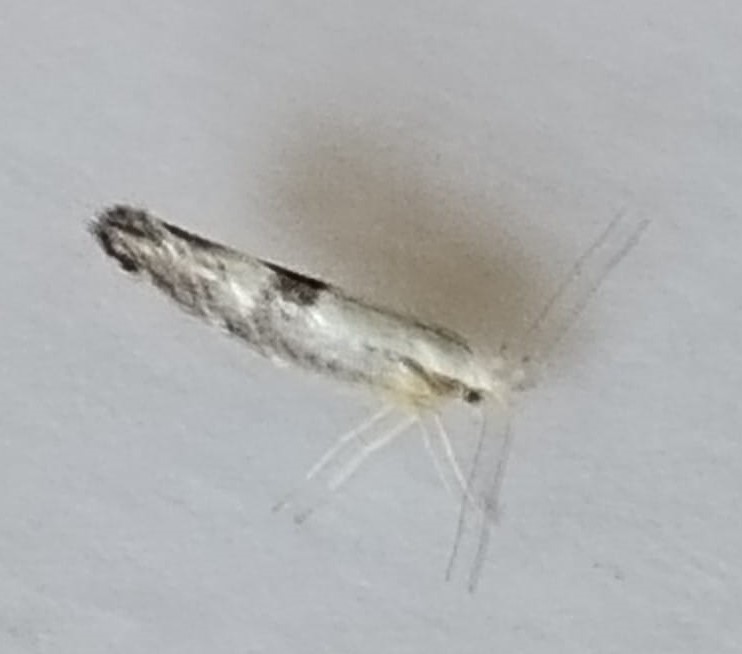
One of the micro moths: Argyresthia spinosella
Also Hans found many in the trap in his garden with a little highlight: Aedia funesta “Særgesnerleugle”, which is rare in Denmark and Scandinavia. That and the fact, that it was a bit worn, indicates, that it is a migrant, which is quite exciting and impressive for such a small, delicate creature.
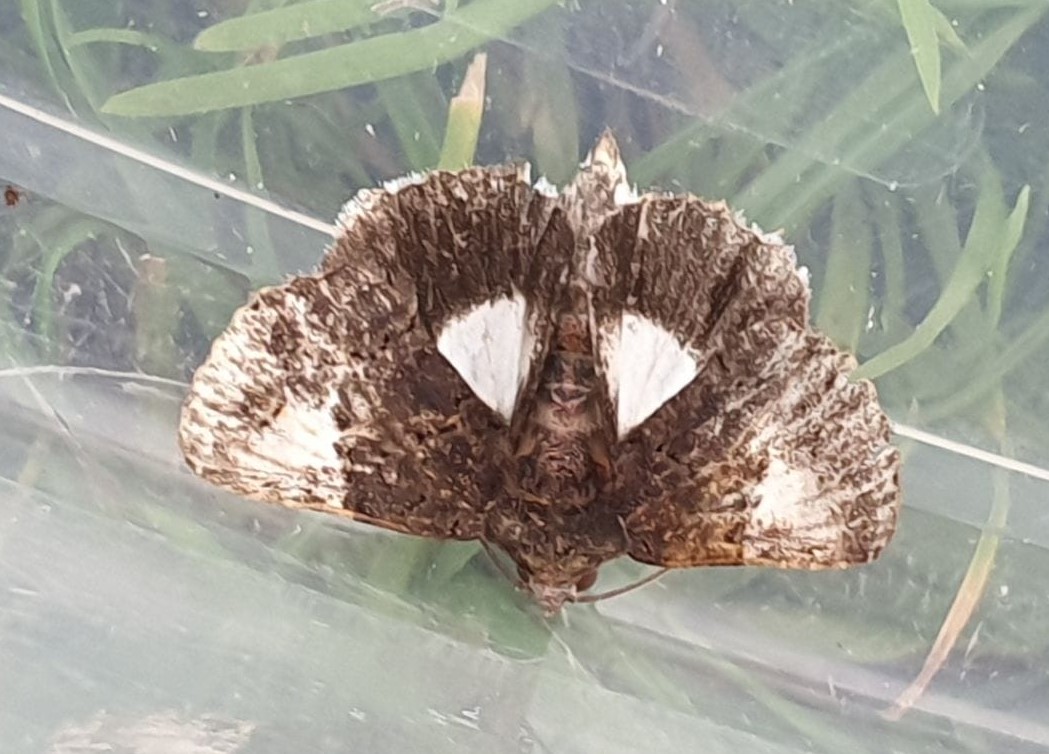
Aedia funesta “Særgesnerleugle”
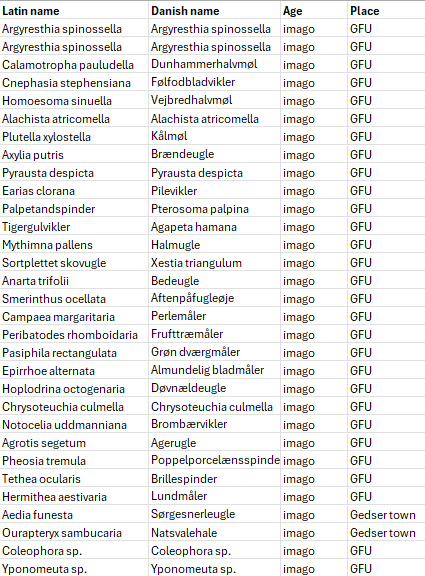
På stationen: Jasper Mosmann, Hanelie Sidhu, Henrik Jørgensen
The baby schema of 1K birds
The ringing:
It was a slow morning, five new birds and two recaptures. Two of the new ringed birds were 1Ks , a Greenfinch “Grønirisk” and a House Sparrow “Gråspurv”.
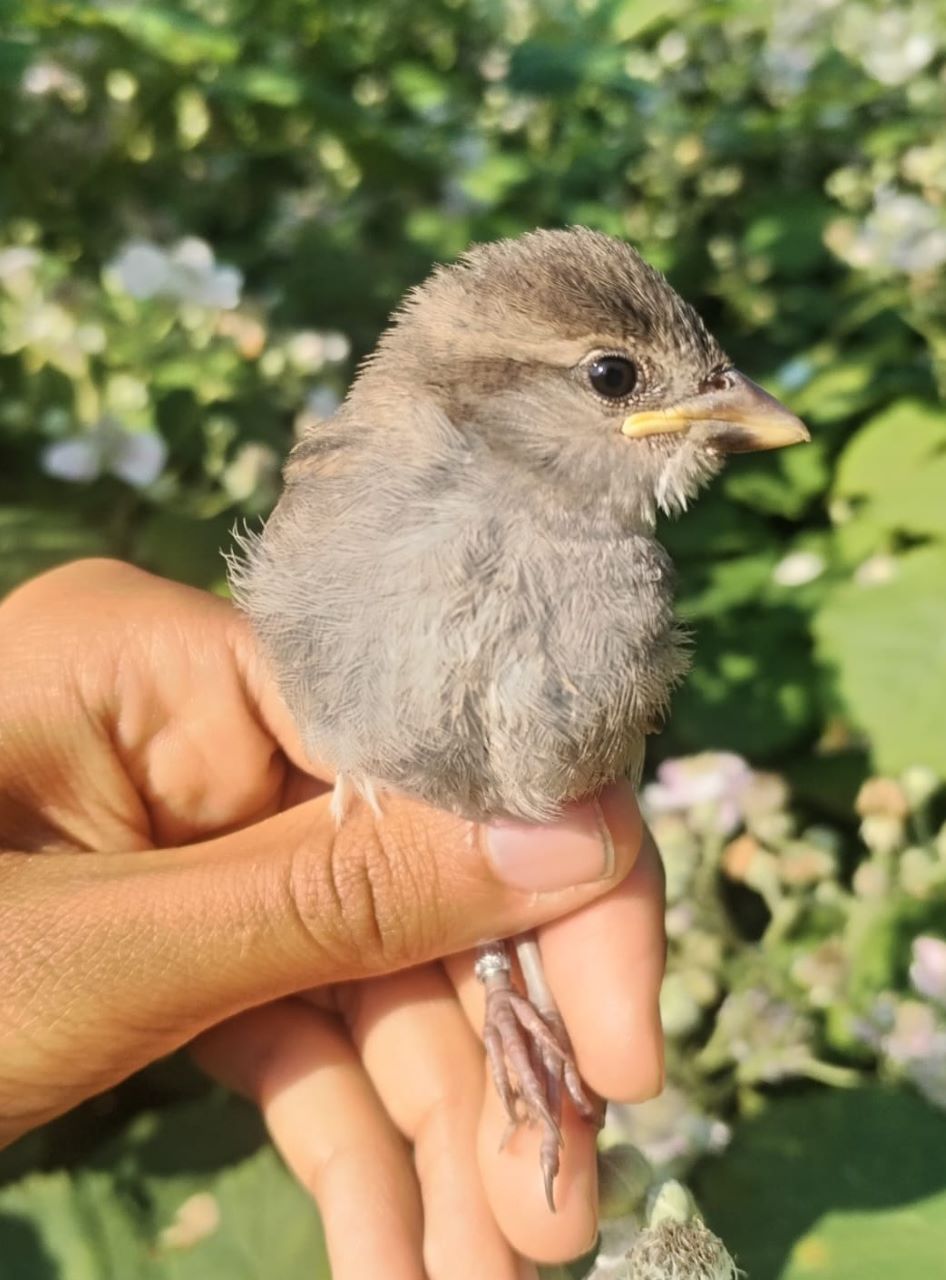
1K House Sparrow "Gråspurv"
June is a slow month, but what I like about that time is the 1K birds, you can´t resist their cuteness.
Next to one of the nets, I found the feather of a Tawny Owl “Natugle”, it was probably not in our garden, but the wind could have brought it. Owl feathers are special, they are extremely soft.
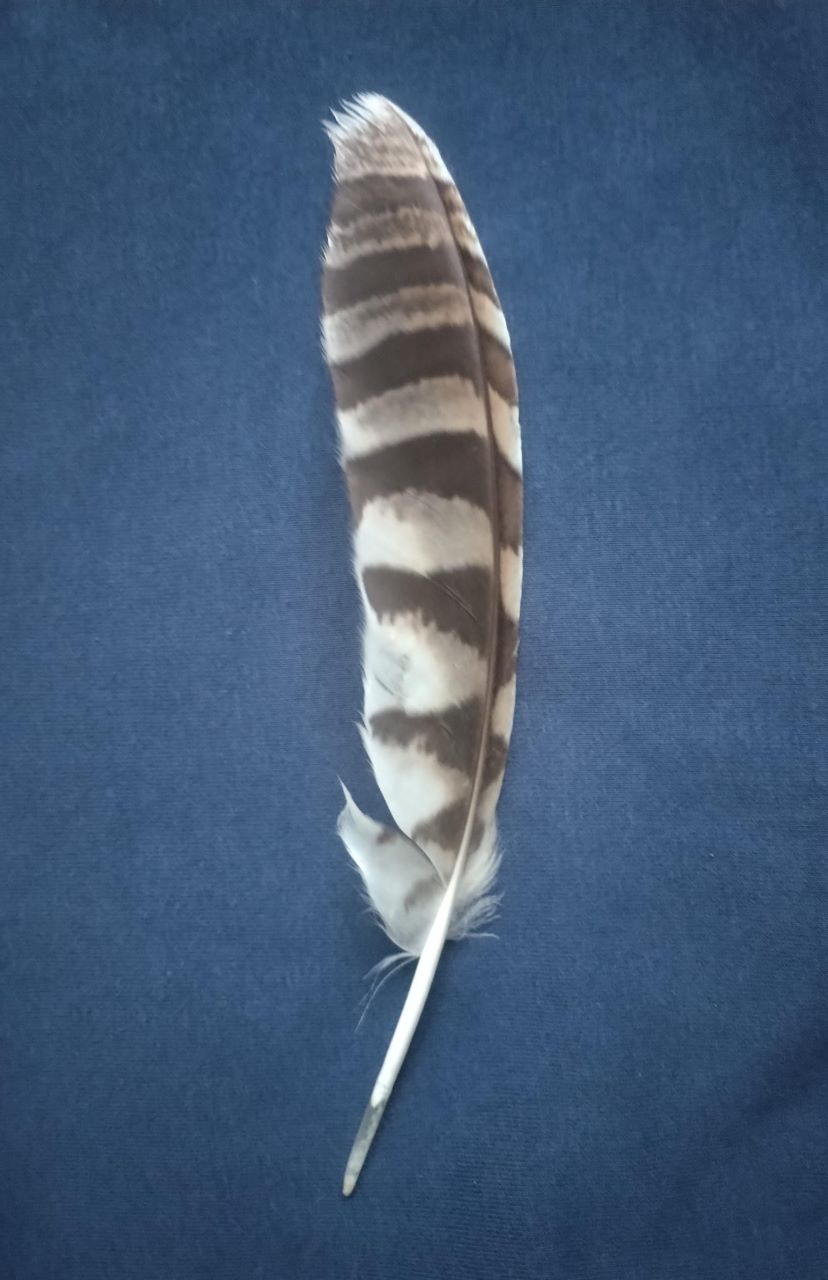
Feather of a Tawny Owl "Natugle"
The moths:
Again, it was 21 species of moths, that I found in the trap today but unfortunately, they were very flighty again. A new species and my favourite of today luckily did not fly away, it was Anania coronata “Hyldehalvmøl”.
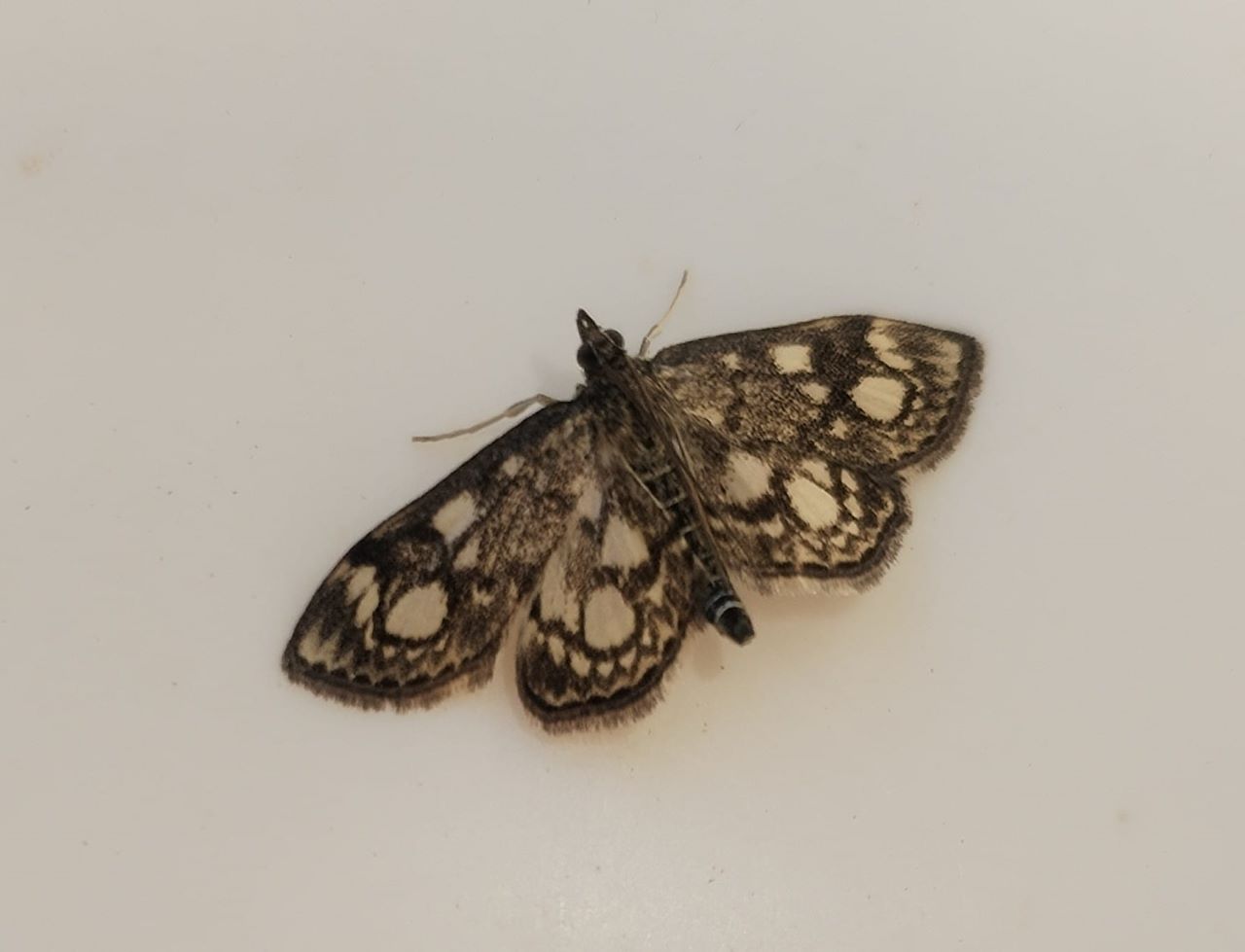
Anania coronata “Hyldehalvmøl”
Later the day, I went along the dyke at Gedesby stand (and tested the sea, it is very good to go for a swim now) and a shimmering moth caught my attention: I caught it and found out that it was Adscita statices “Metalvinge”, a common but very pretty species.
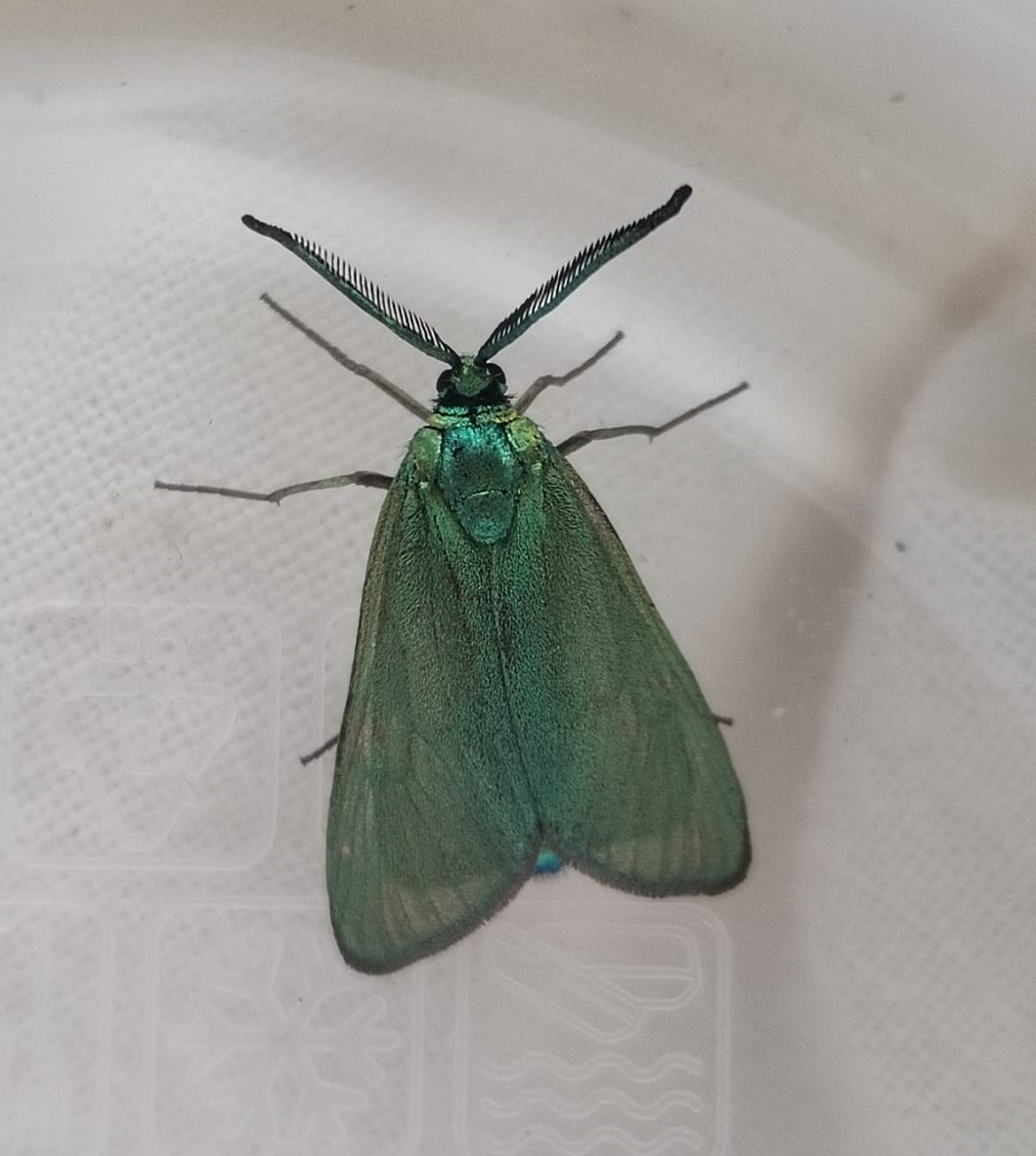
Adscita statices “Metalvinge”
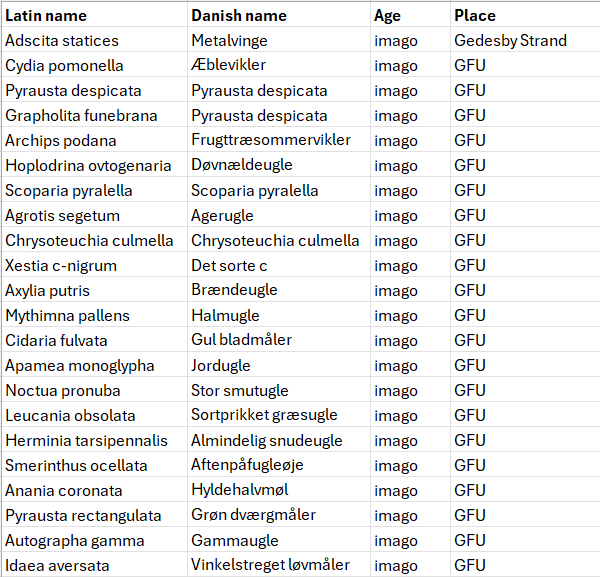
People: Henrik Jørgensen, Hans Lind, Jasper Mosman, Hanelie Sidhu
Somewhere over the rainbow
Ringmærkningen:
Det var meget lunt med 17 grader da vi gik ud 3.45 for at sætte nettene op.
I dag var vi tilbage til normal, hvor de sidste 4-5 runder var tomme.
Vi havde besøg af Doro fra Tyskland de fleste runder fra start af og heldigvis var der fugle på de runder hun var med til.
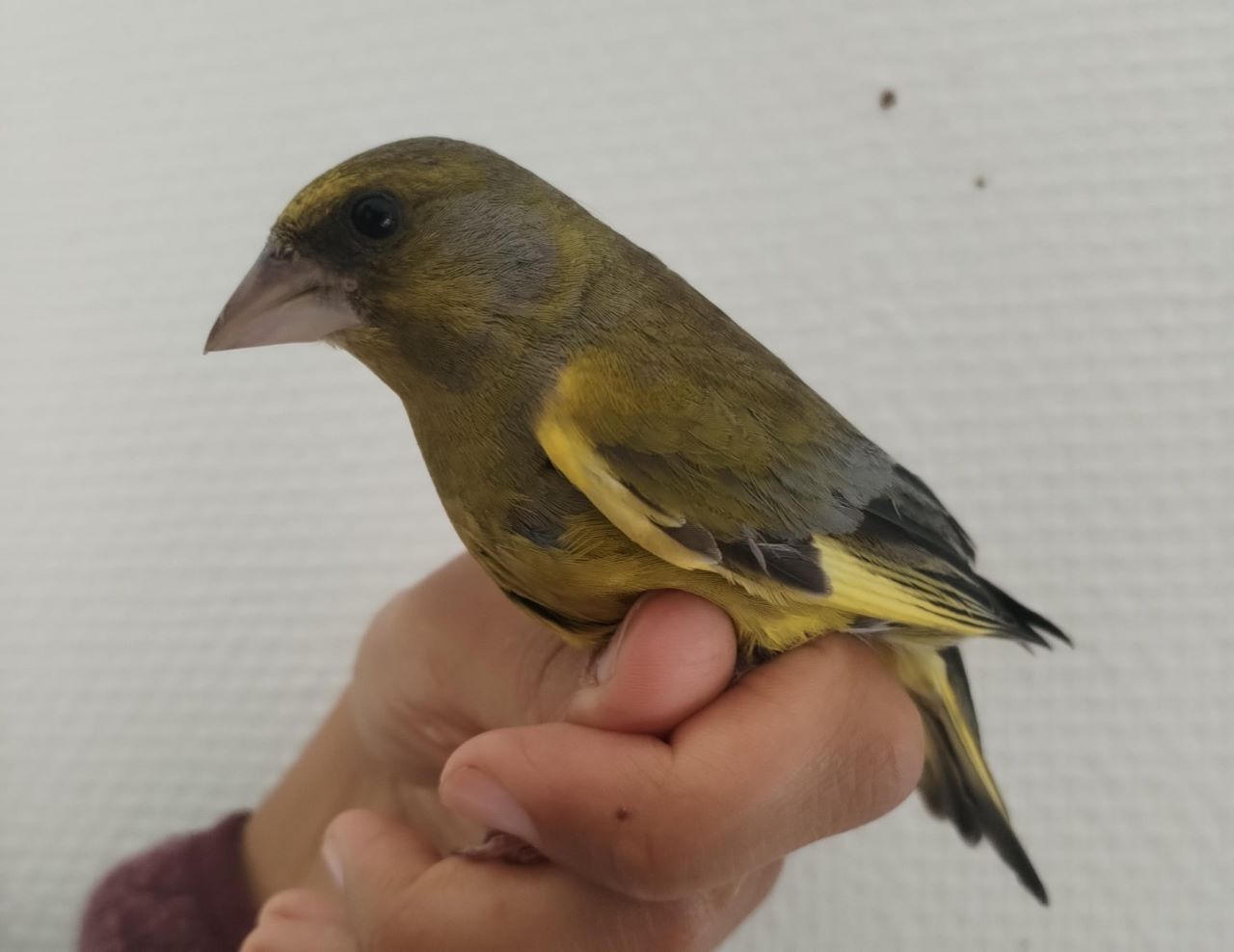
The moths:
It was not a bad day for catching moths, I had 22 species in the trap and many individuals of Cidaria fluvata "Gul bladmåler", which Hans also had in his trap.
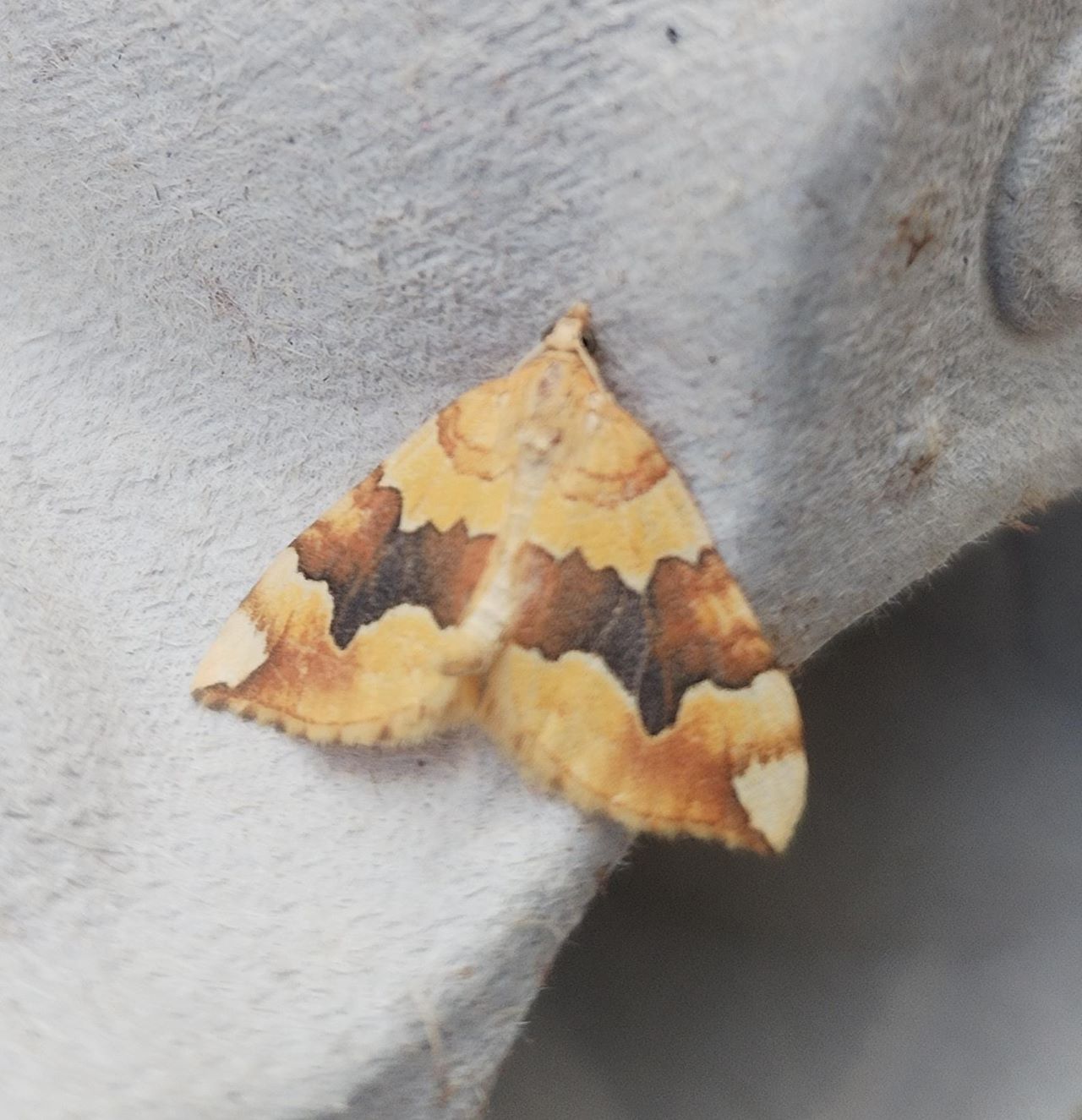
Cidaria fluvata "Gul bladmåler"
Later in the day, I went to Bøtø skoven and found a petty new moth, which is quite common: Cabera pusaria "Snehvid stregmåler"
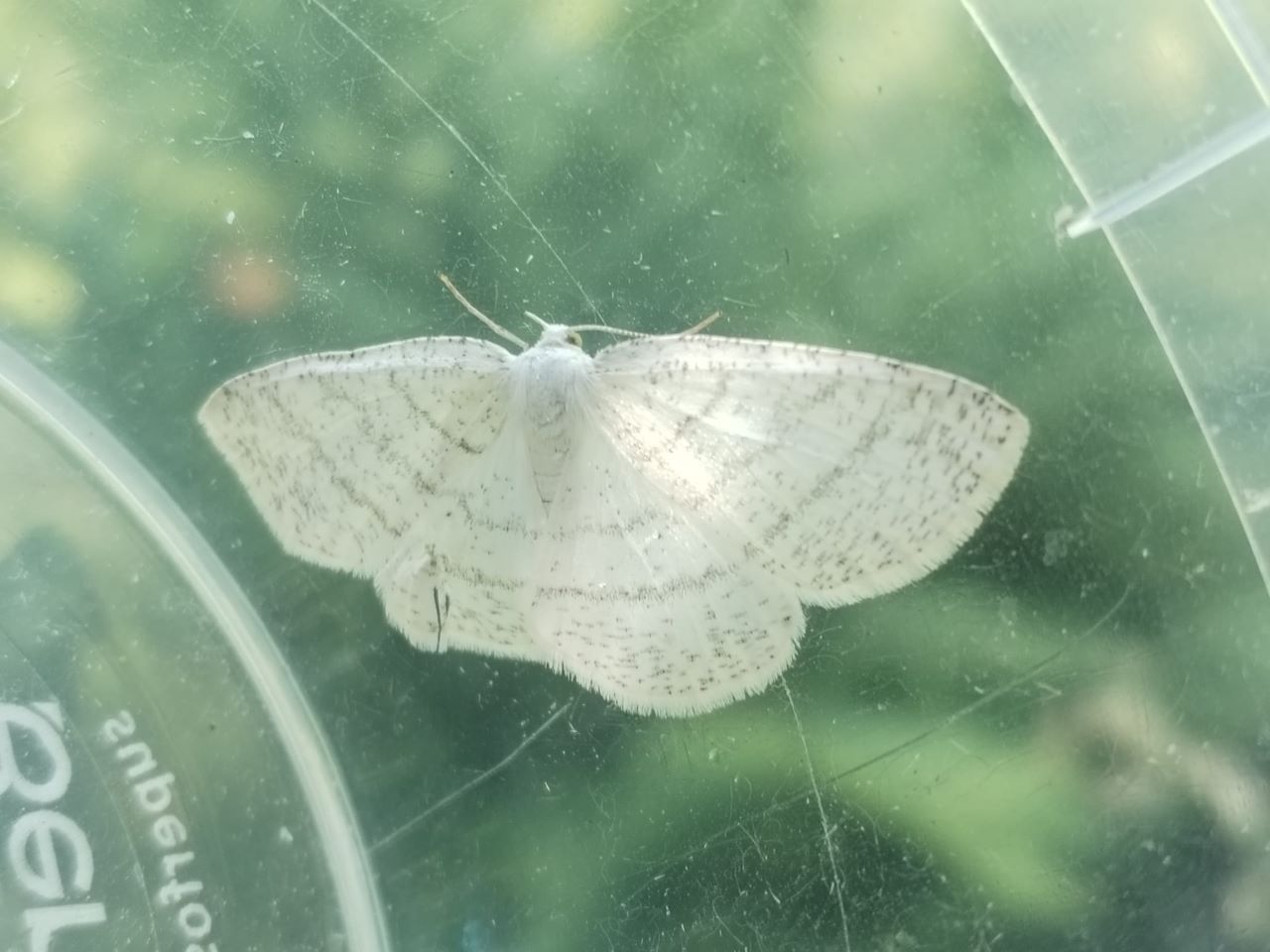
Cabera pusaria "Snehvid stregmåler"
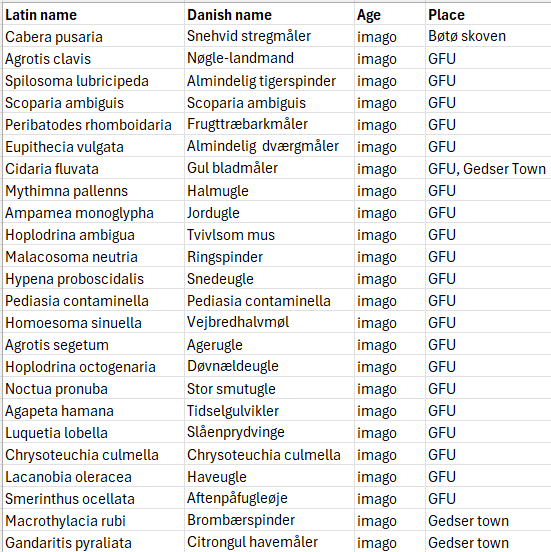
På stationen: Hanelie Sidhu, Jasper Mosmann, Henrik Jørgensen
Summer day with Bysvale and Tornsanger
The ringing:
After opening nets together this morning, I took poles with a net on and ringing equipment and went to the tip to catch Swallows. I set up the net there, but the light was a bit diffuse while we were opening nets because there was so much moisture in the air, the sun was going up now and I was worried, the net would be too visible for the Swallows. But after a while, I had success, one of the House Martins “Bysvale” which has a nest with chicks there, went into the net.
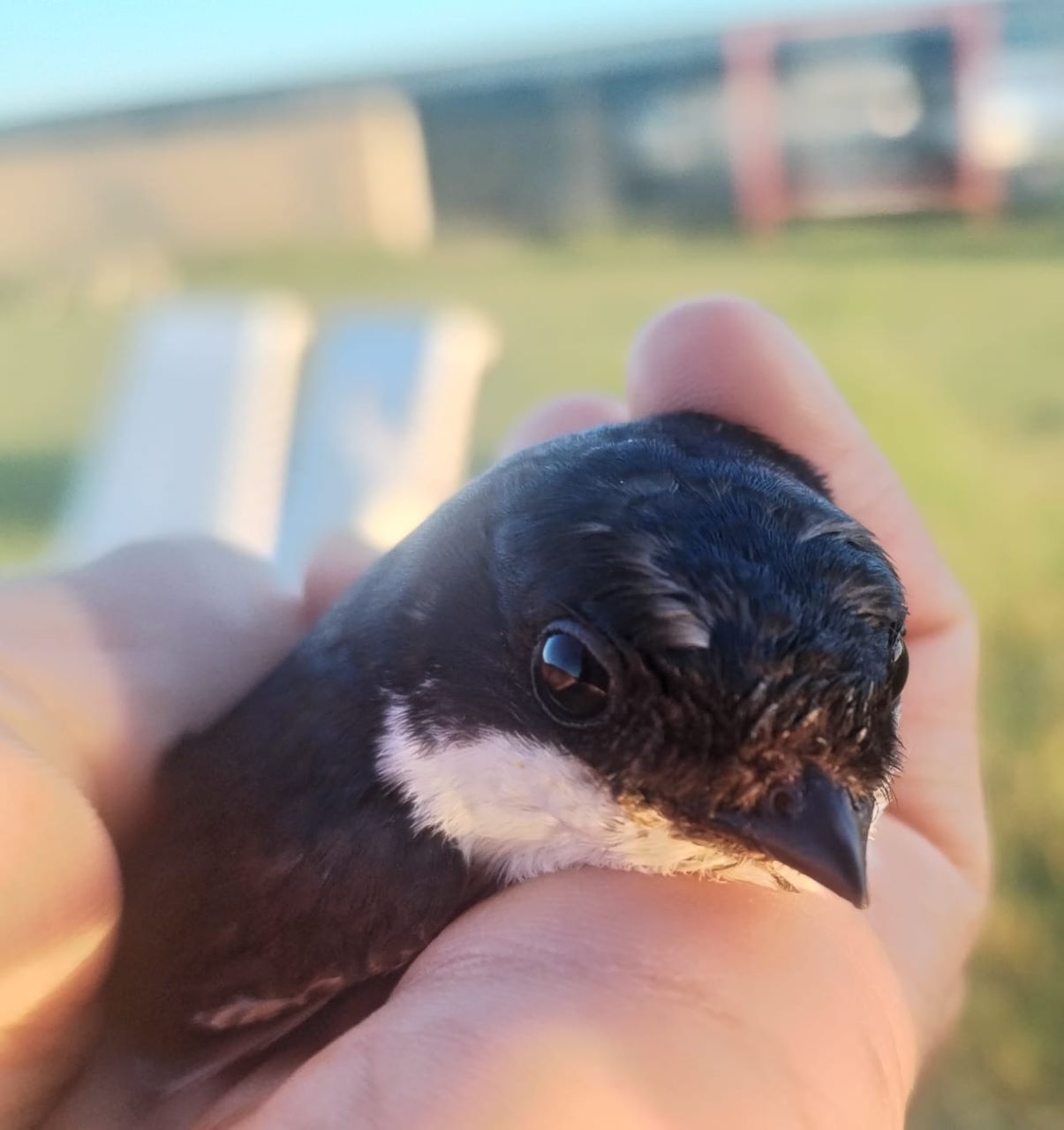
House Martin "Bysvale"
But after, Barn Swallows “Landsvale” flew very close and turned just before going into the net. I closed before most of the tourists would wake up and went back to the garden. It was just time for a round when I came. In my round after that, I got a little surprise, in the last net, just before going to the lab were four birds! This is quite unusual for this time (and this spring in general). When I came closer, I saw that it was very young Common Whitethroats “Tornsanger”, probably on the first trip out of the nest. It nearly felt like ringing chicks from the nestbox, all four got into one bag and after they got a ring on, they were released close to the net, the parents could find them and they could continue their adventure.
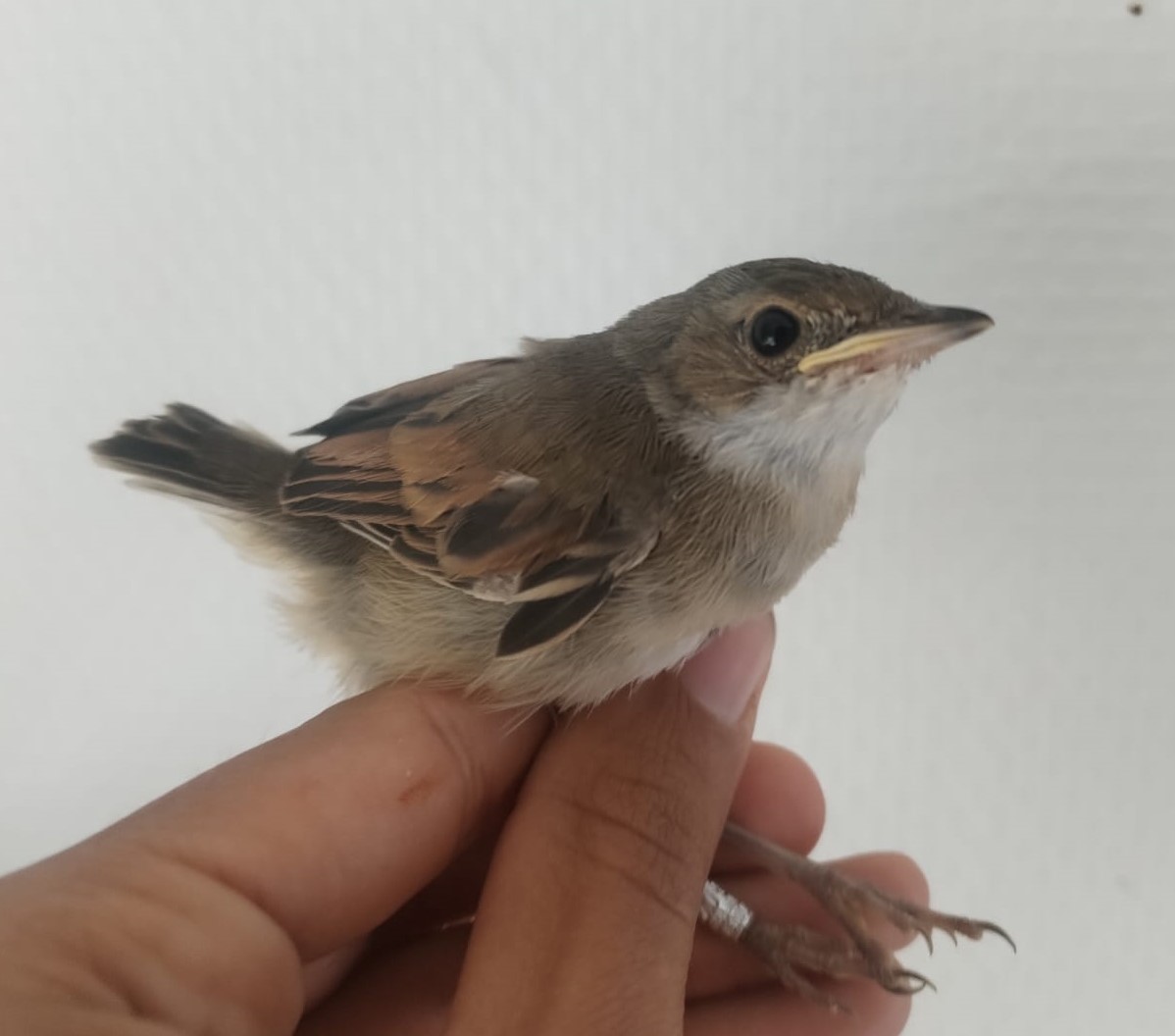
One of the four Common Whitethroat "Tornsanger" siblings
It was an okay day for ringing but in the last rounds it slowed down a lot and it got very warm, one of the first real summer days in Gedser.
The moths:
I found twenty moth species in the trap today. That was not too bad and there some new species. There were two species, that looked very much alike, Idaea dimidiata “Sortplettet løvmåler” and Anania perlucidalis “Kåltidselhalvmøl”, at first I thought it was just a variation of the same species. Look at the pictures, it is mostly the point, where the black spot on the wings is placed, which helps to differentiate them.
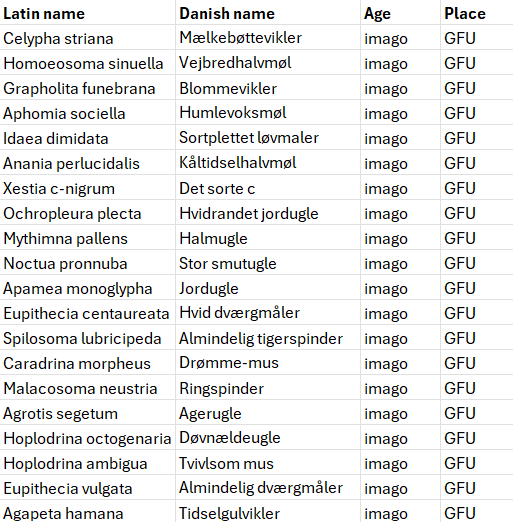
People: Jasper Mosman, Gert Jeppesen, Henrik Jørgensen, Hanelie Sidhu
En hvid(t) dag!
The ringing:
This morning was the best since the end of May. Considering the low numbers this spring (except March) we cannot call it a wild day. But a hvid day: Two White Wagtails “Hvid Vipstjert” went in the nets, a young 1K bird and probably one of his parents, which already had a ring on.
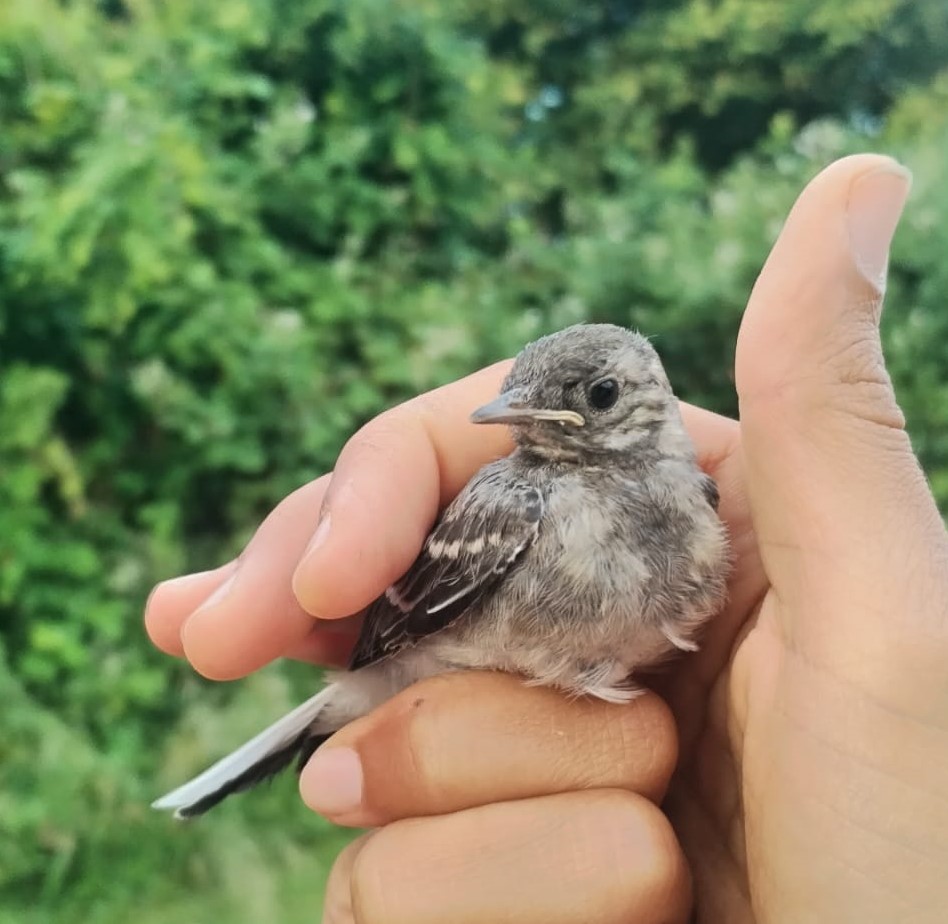
1K White Wagtail "Hvid Vipstjert"...
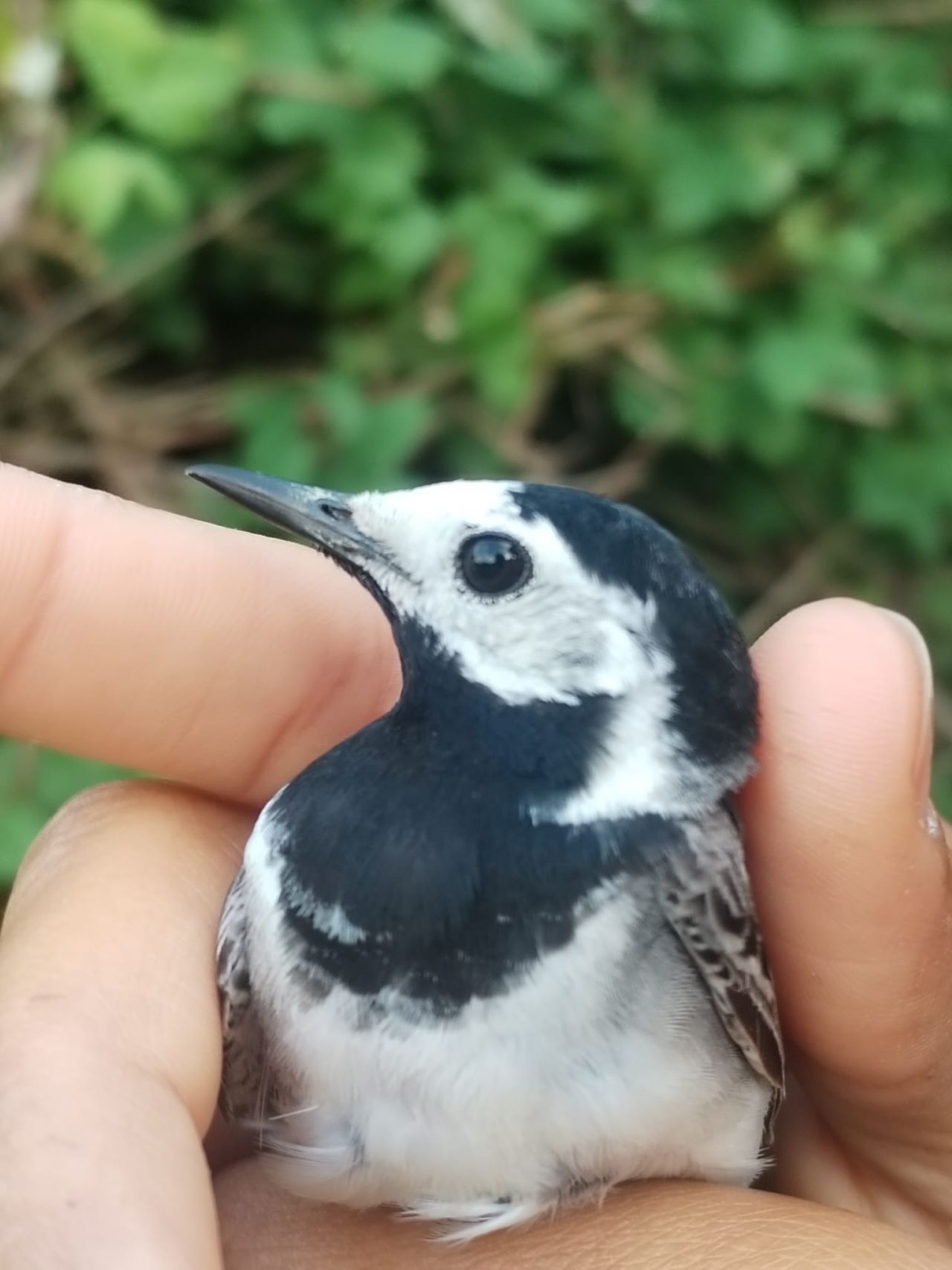
...and parent.
Also, two Great Spotted Woodpeckers “Stor Flagspætte”, Henrik and I each had one.
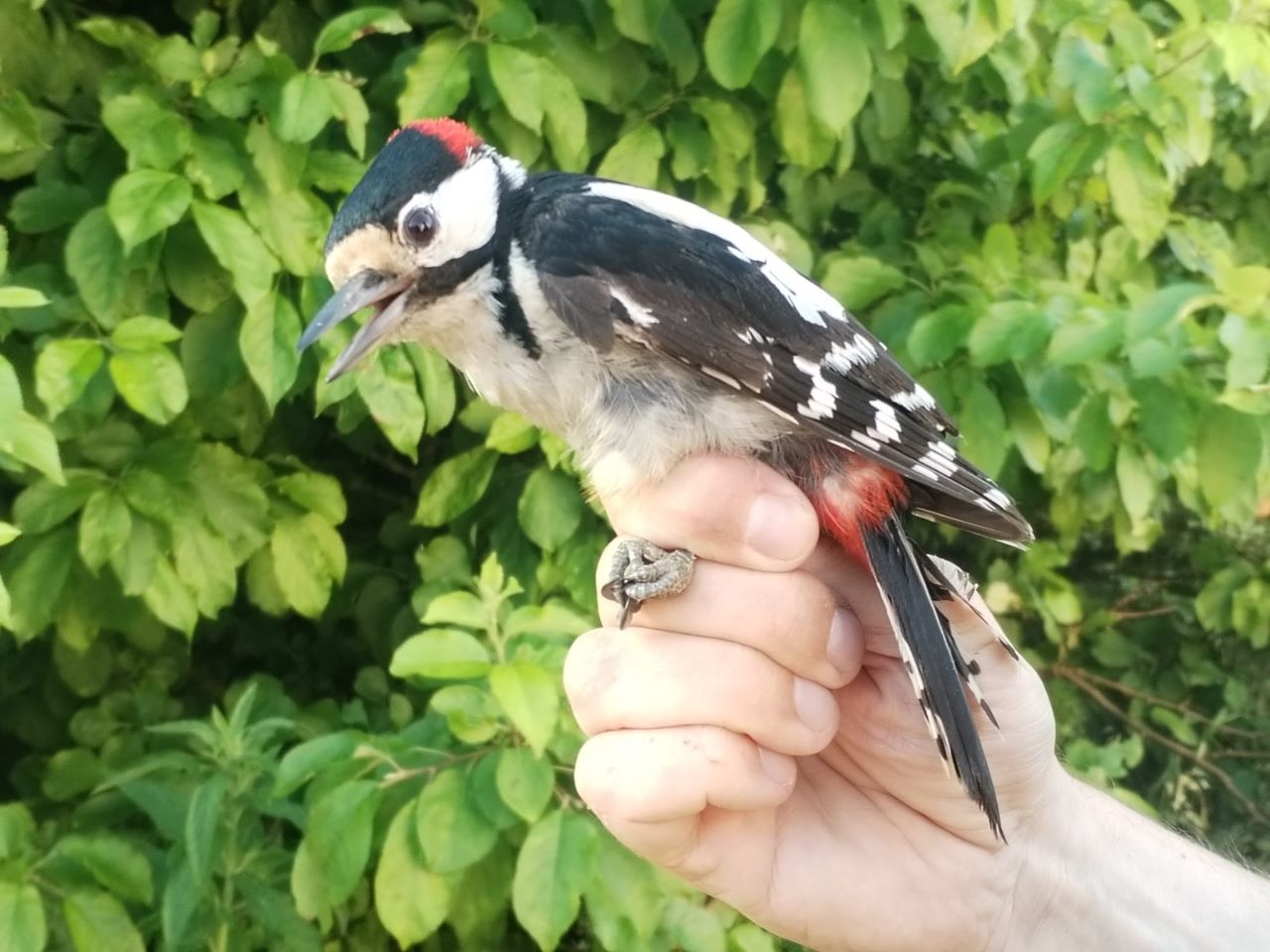
Great Spotted Woodpecker "Stor Flagspætte"
In the closing round, Henrik got a Thrush Nightingale “Nattergal”. So there were some nice species in the nets today and it was not a boring morning.
The moths:
Finally, a warm and sunny morning, how it is supposed to be in June and she is complaining? Just a little, but yes, because I feel like the warmth makes the moth quite flighty so I think there were two that might have been new and that escaped before I could take a picture. But still, I was happy with the moths this morning, especially about one new for me, that I was hoping to catch: Pterophorus pentadactyla “Hvidt fjermøl”.
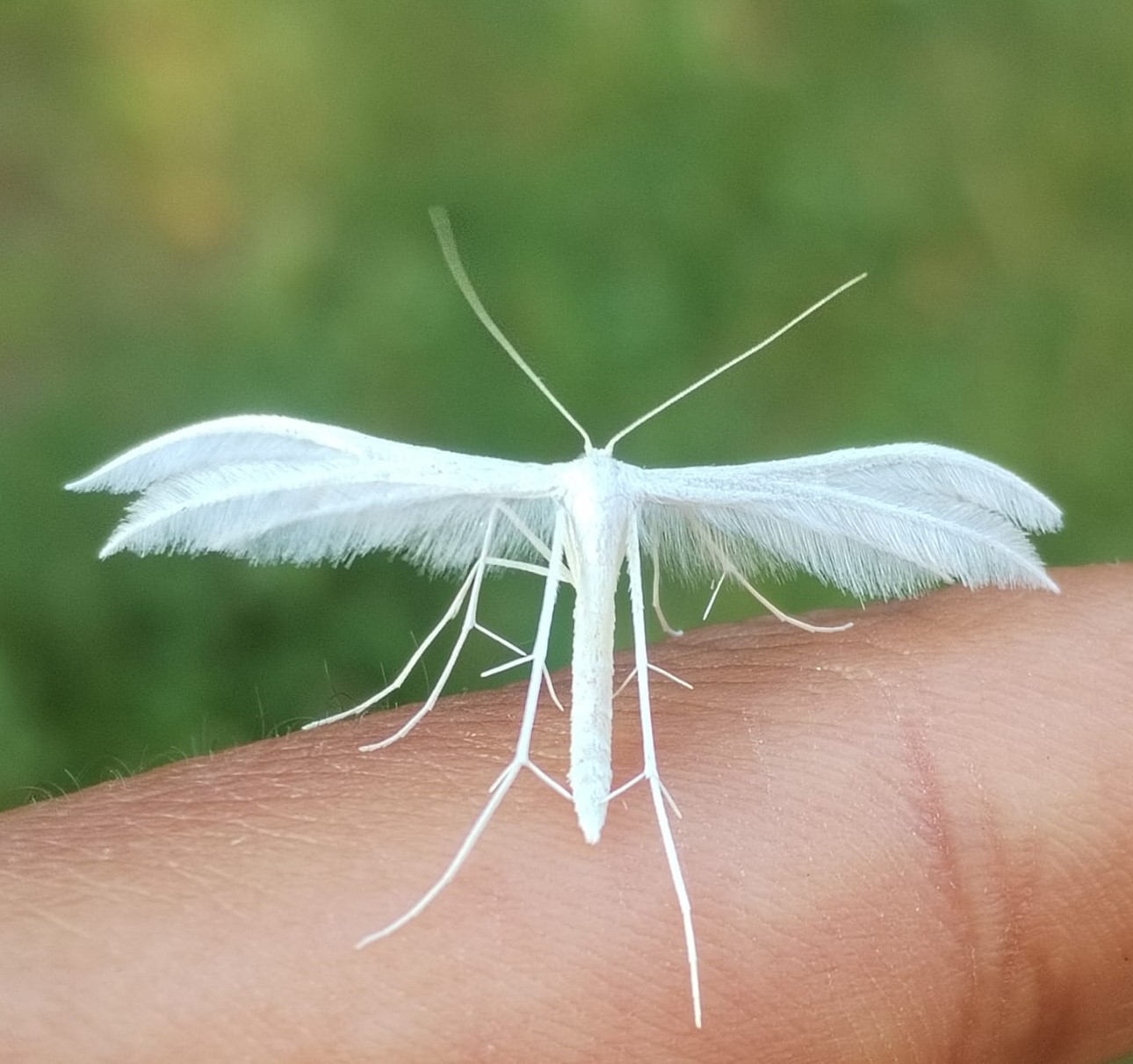
Pterophorus pentadactyla “Hvidt fjermøl”
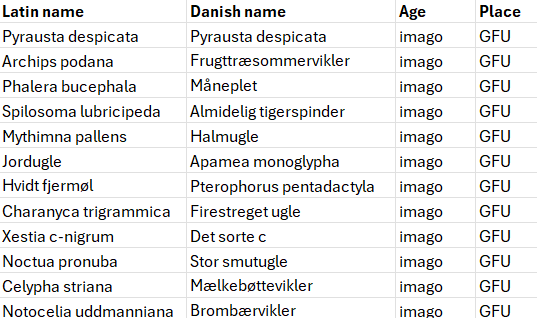
Some of the moths camouflage very well on wood so I sometimes put them on the firewood in the garden. When I came with one of the moths, I saw a tail coming out under the bark of a log. Carefully, I lifted the bark, there was a lizard underneath, which did not seem to bother much. I took some very close pictures until putting the bark back again. It was of the species Zootoca vivipara “Skovfirben” not rare, but nice.
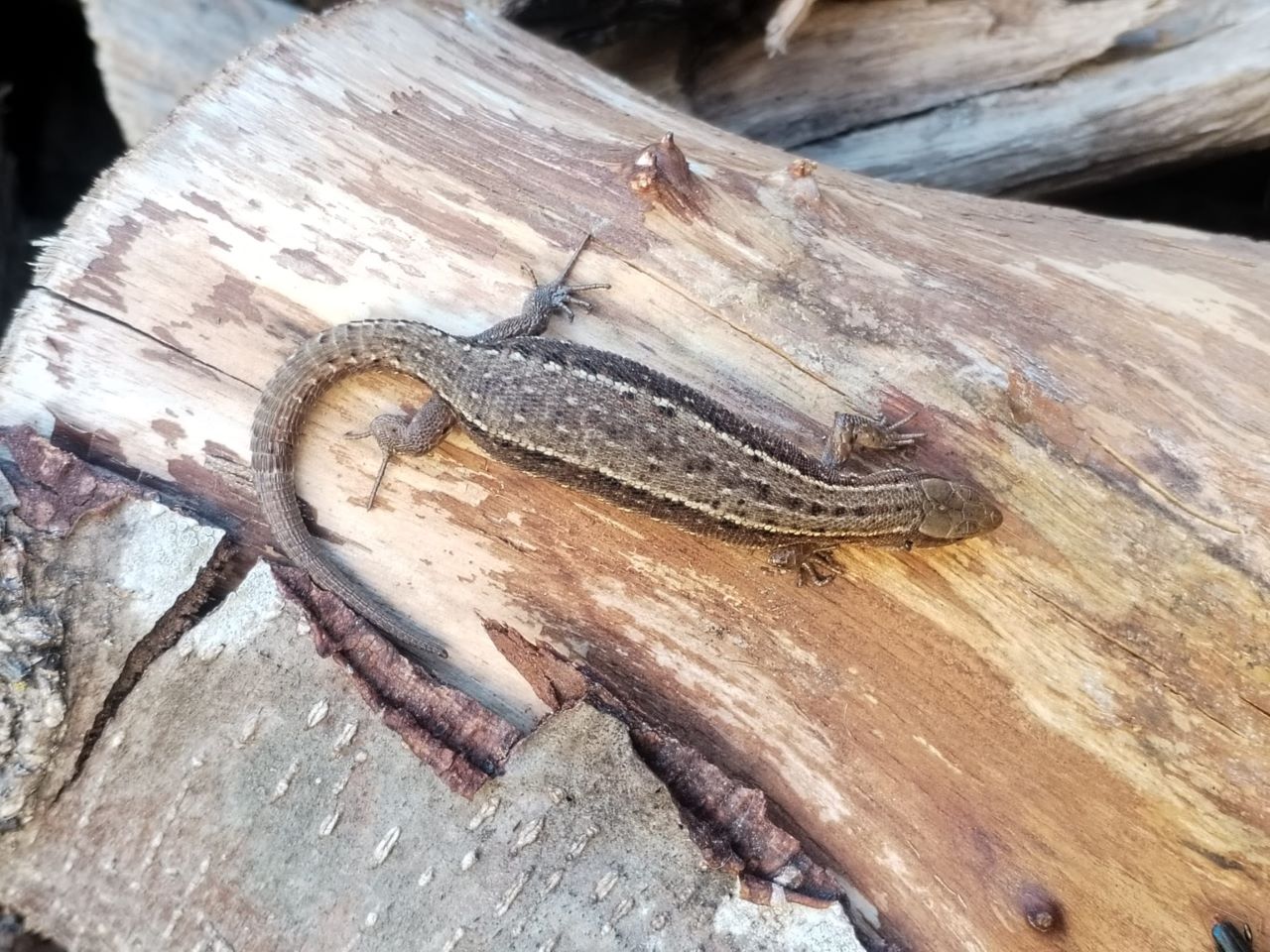
Zootoca vivipara “Skovfirben”
The same with the beetle, Dorcus parallelipedus “Bøghjort”, that was sitting on our wall today.
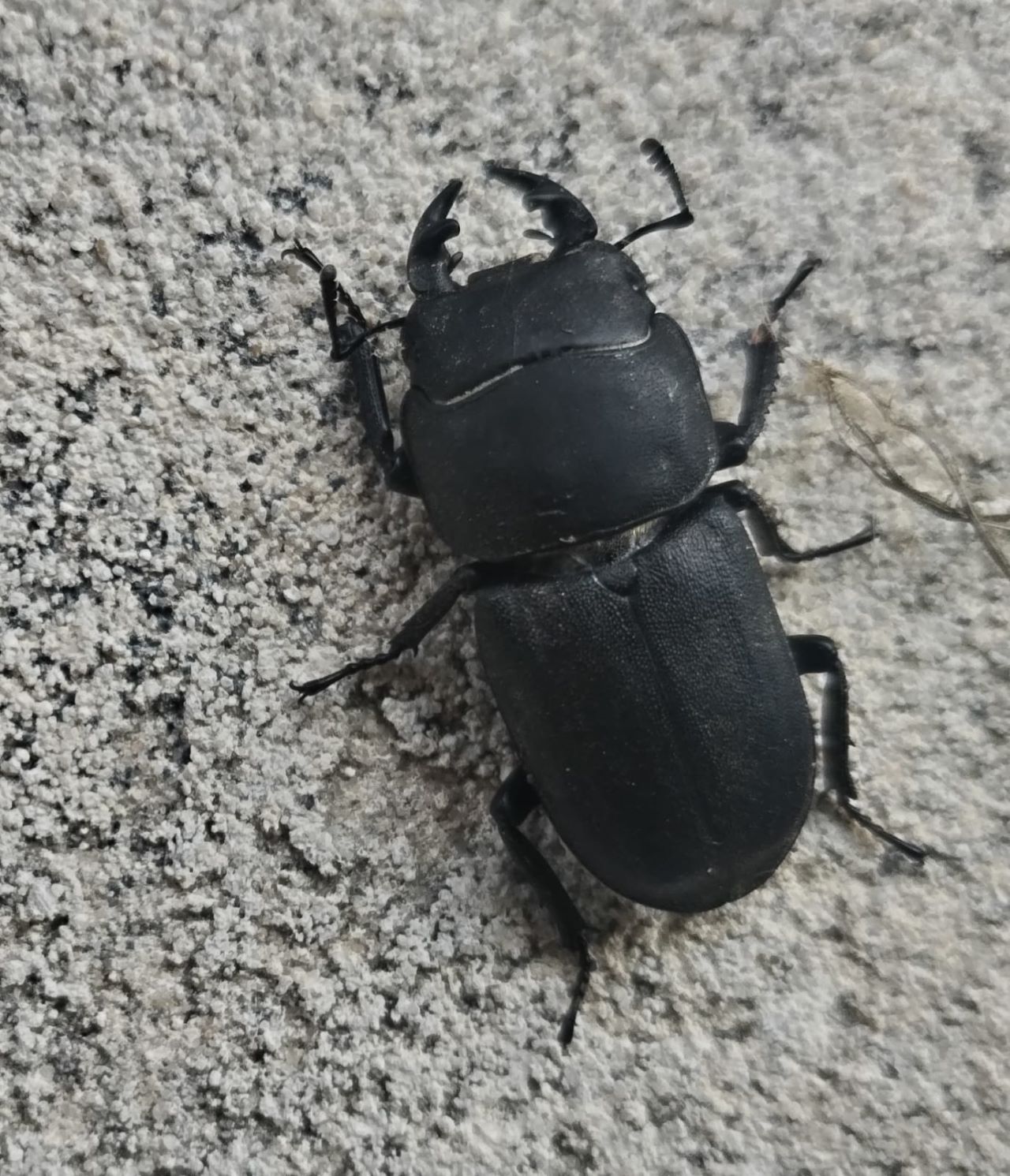
Dorcus parallelipedus “Bøghjort”
Jasper came back to the station today after spending a nice weekend with his sister and her boyfriend, who came to Denmark on holiday.
People: Jasper Mosman, Hans Lind, Signe Gartig, Henrik Jørgensen, Hanelie Sidhu
A bad season for our long-distance migrants
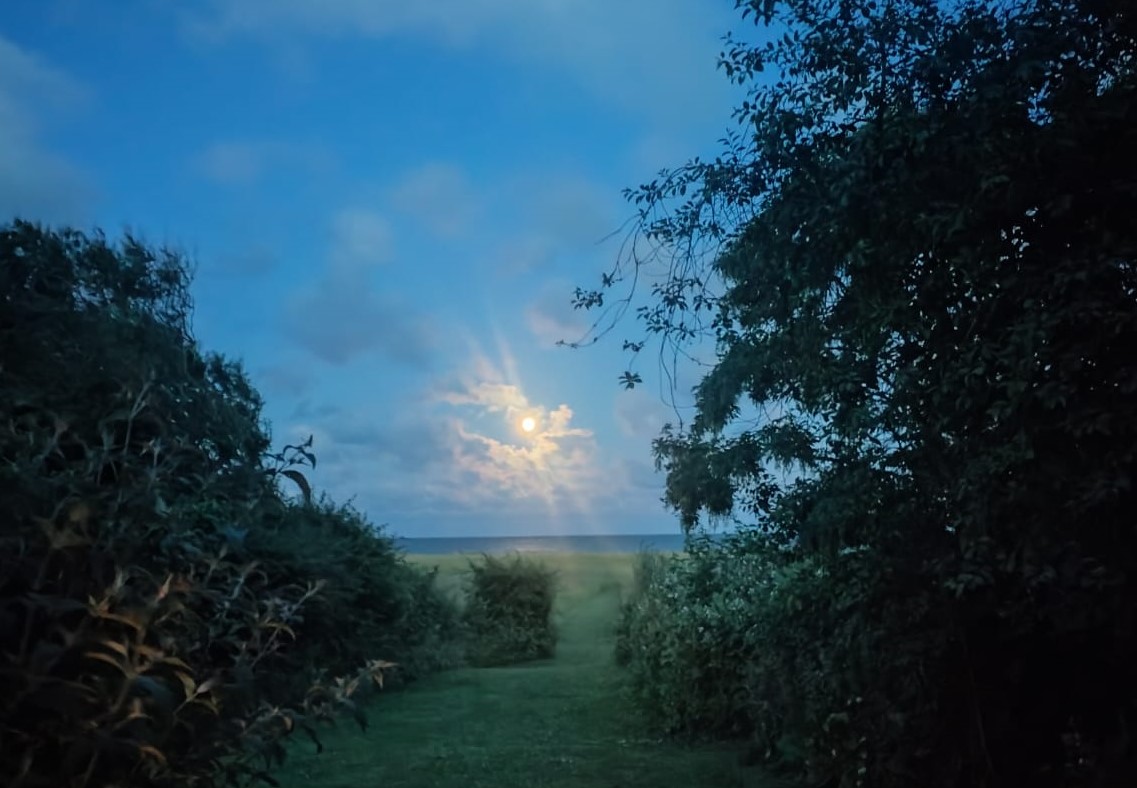
The moon over the sea when we opened the door this morning. Nearly a bit kitchy, this picture...
The ringing:
Early in the morning, Signe arrived at the station to join Henrik and me in the ringing. She extracted her first birds, which went very well, but unfortunately, there were not many to practice much, just four new ones and one recap. The only bird that Henrik got in one of his rounds was a little surprise, a 1K Song Thrush “Sangdrossel”.
As there is not much to write about this morning, I will continue my little analyses of this season. A week ago, when I presented you the season totals of this year compared to last year and five years ago, I promised to look a bit more into a few species. Now I found some time for that, I looked at three Long-distance migrants, the Icterine Warbler “Gulbug”, the Lesser Whitethroat “Gærdesanger” and the Willow Warbler “Løvsanger”. When I looked at the abundance of new-ringed birds of different common species in mid-May, I wrote, that we are not even so bad with the long-distance migrants. Looking at the totals now, this interim balance can not be confirmed. All three long-distance migrant species have the lowest abundances this year compared to the previous year and 2019.
Especially abundances of the Icterine Warbler "Gulbug" were really low. We would not have expected that, as this is the bird that we hear in the garden every morning, but especially newly ringed Icterine Warblers “Gulbug” were alarmingly low, just 35 Icterine Warblers “Gulbug” were ringed this year.
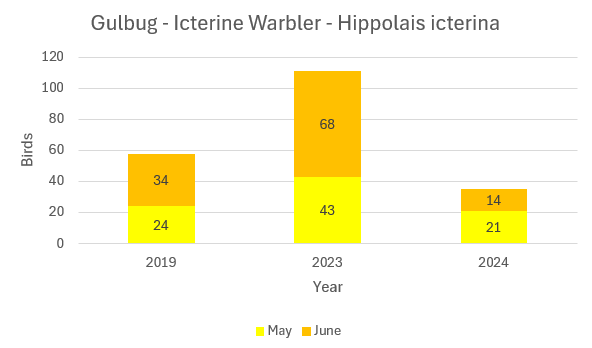
These diagrams just include newly ringed birds, we also got some recaptures of Gulbug “Icterine Warblers” from the previous years, but it indicates low abundances of that species. We did not get any young 1K birds in the nets, still just adults with brood patches, so let´s hope the breeding season goes well.
Also the abundance of new-ringed Willow Warblers “Løvsanger” is very low, not even half of the season total of last year have been ringed this year: Last year 230 birds got a ring in Gedser during the spring season, this year it was 93.
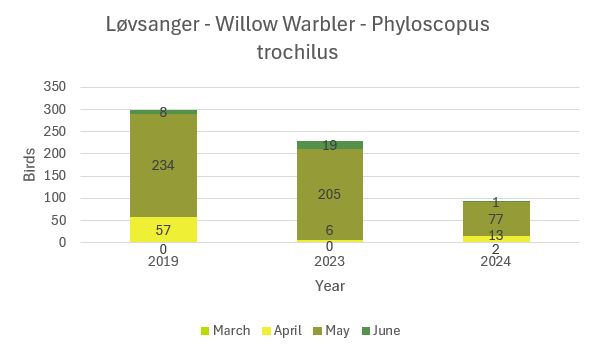
The Lesser Whitethroat “Gærdesanger” is doing best of the three species, although we also have a low season total this year, it was not as much lower than last year's season total as in the other species. 100 were ringed this season, while it was 128 in 2023 and 184 in 2019.
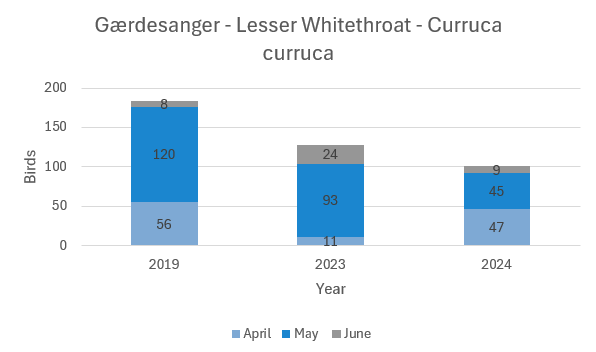
I already prepared season totals for short-distance migrants and I you can look at the diagrams one of the next days, so stay tuned, it is worth reading our daily blog!
The moths:
After yesterday, the trap was very well-prepared last night, the light was even checked when it got dark. All good this night, but the weather did not reward me for that. Again, it was a quite windy night which made just very few moths fly also Hans did not have much and nothing special. So I will put a picture of a very common moth, that you can also see active during the day on grass for example, it is Crambus lathoniellus.
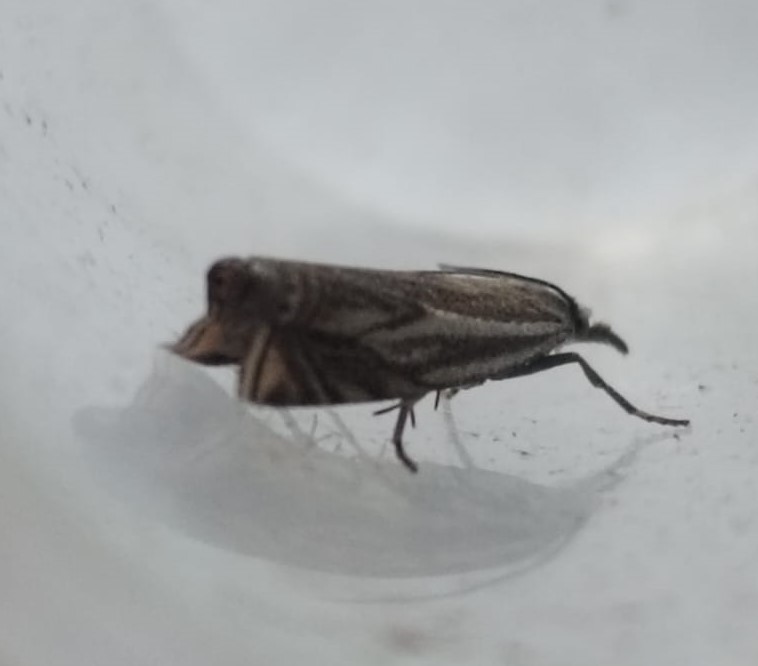
Crambus lathoniellus

Today, a Collared Pratincole “Rødvinget Braksvale” had been reported at Bøtø. Mads, Gert and I went to Bøtø looking for it, but without success this time. Maybe tomorrow.
People: Mads Elley, Gert Jeppesen, Signe Gartig, Henrik Jørgensen, Hanelie Sidhu
Arbejdsdag
The ringing:
Det blev endnu en ret stille dag hvor 2 af de 6 fugle var nye.
Det var næsten vindstille da nettene skulle op, men vinden tog så meget til at et enkelt net måtte lukkes.
The moths:
No moth catching at the station today, as yesterday morning, before I went to the trap, I plugged the light of, when it is still dark, the UV light can be quite uncomfortable for the eyes, so I started to plug it of, before collecting the moth in the morning. Unfortunately yesterday, I forgot to plug it in again. Now, it is pluged in again and ready for the moth tonight!
Hans had light on in his garden during the night. Some of his highlights in the trap were Acronitcta aceris “Ahornugle" and Spilosoma lubricipeda “Plettet Tigerspinder”.
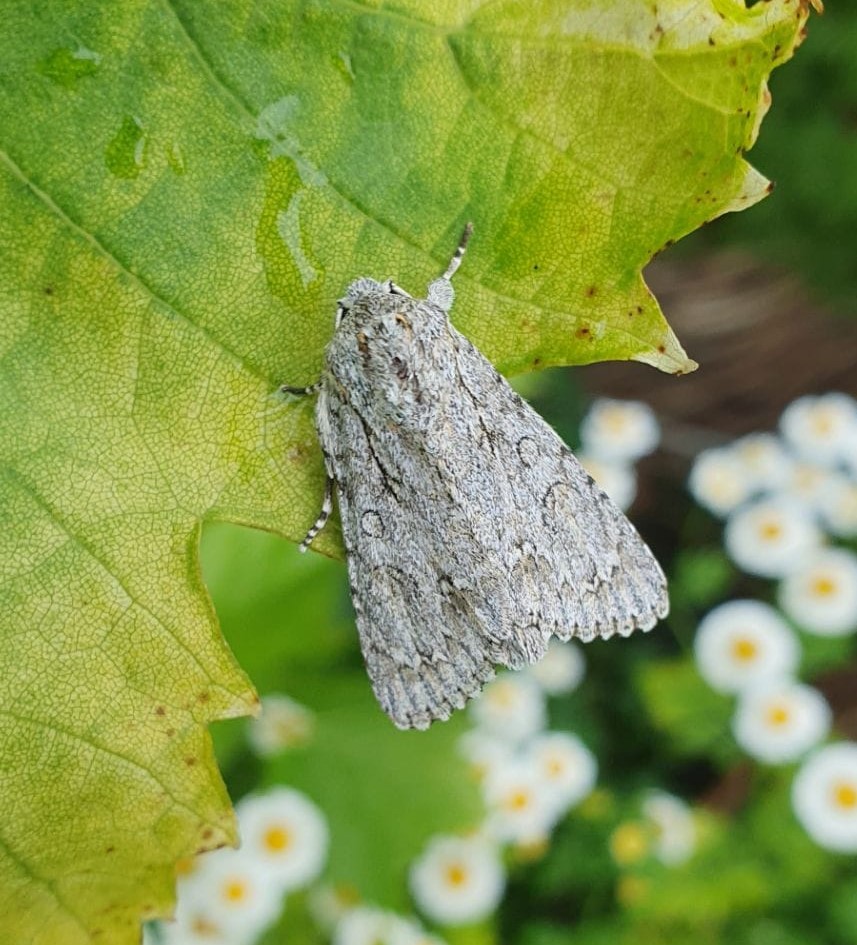
Acronitcta aceris “Ahornugle"
News of the station:
Ole tog hjem til Berlin i morges, og lidt senere tog Jasper også afsted for at se noget familie men er tilbage mandag morgen.
Ved 10 tiden kom en masse da der var havedag. Alle netgader plus en stor del af haven blev trimmet så nu er det hele top.
Vi fik besøg af 2 fuglefolk fra Rostock (Tyskland), hvoraf den ene har været forbi flere gange og de gav også en hånd med hele dagen.
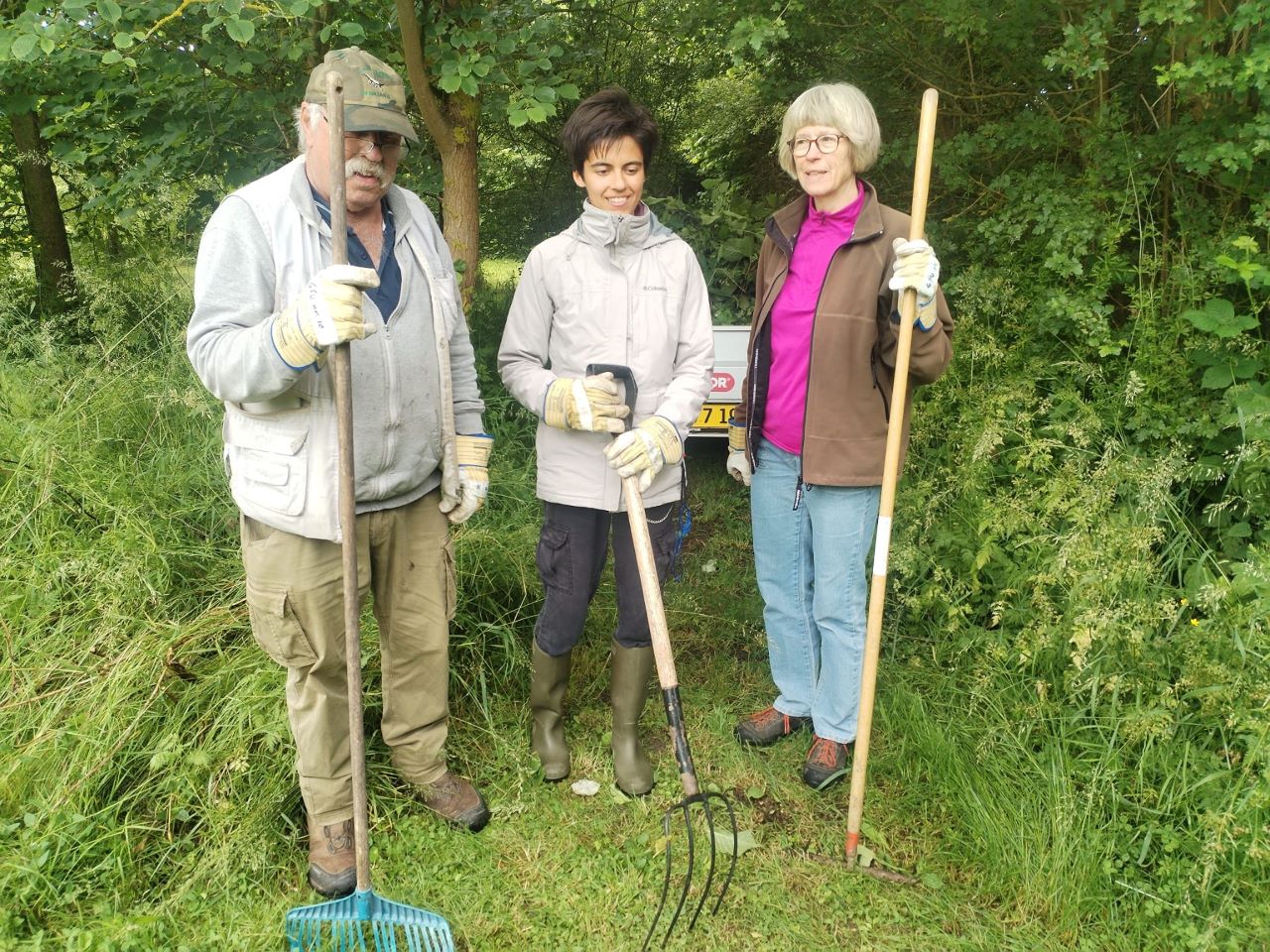
Some of the gardening volunteers on a little pause from work. Foto: Louis Hansen
På stationen: Henrik Jørgensen, Hanelie Sidhu, Signe Gartig og hendes far, Gert, Mads, Tina, Louis, 2 X Rostock, Benny, Esther.
Endnu en dag med 'sort' andetræk
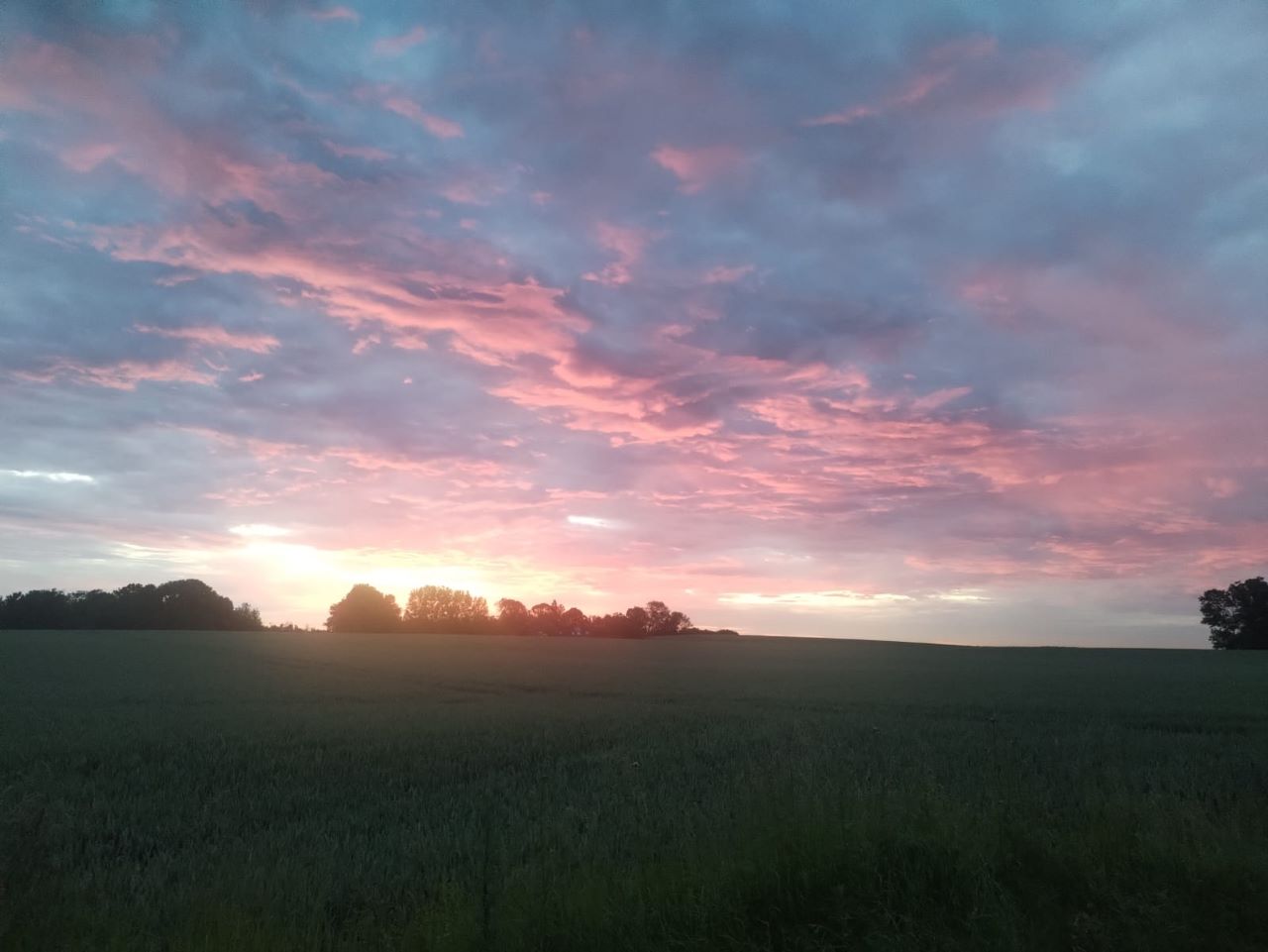
Sunrise over the fields of Gedser
The ringing: Da nettene skulle op lød der en gryntende lyd som jeg først troede var pindsvine som sloges, men da jeg kom nærmere lød det mere som en som snorkede. Så tænkte at der måske var nogen som havde slået telt op, men jeg fik hurtigt opdaget at det var et rådyr som åbenbart havde stået og sovet og at det så var den som snorkede.
Ellers var dagen pænt stillle, men årets første unge grønirisker blev fanget.
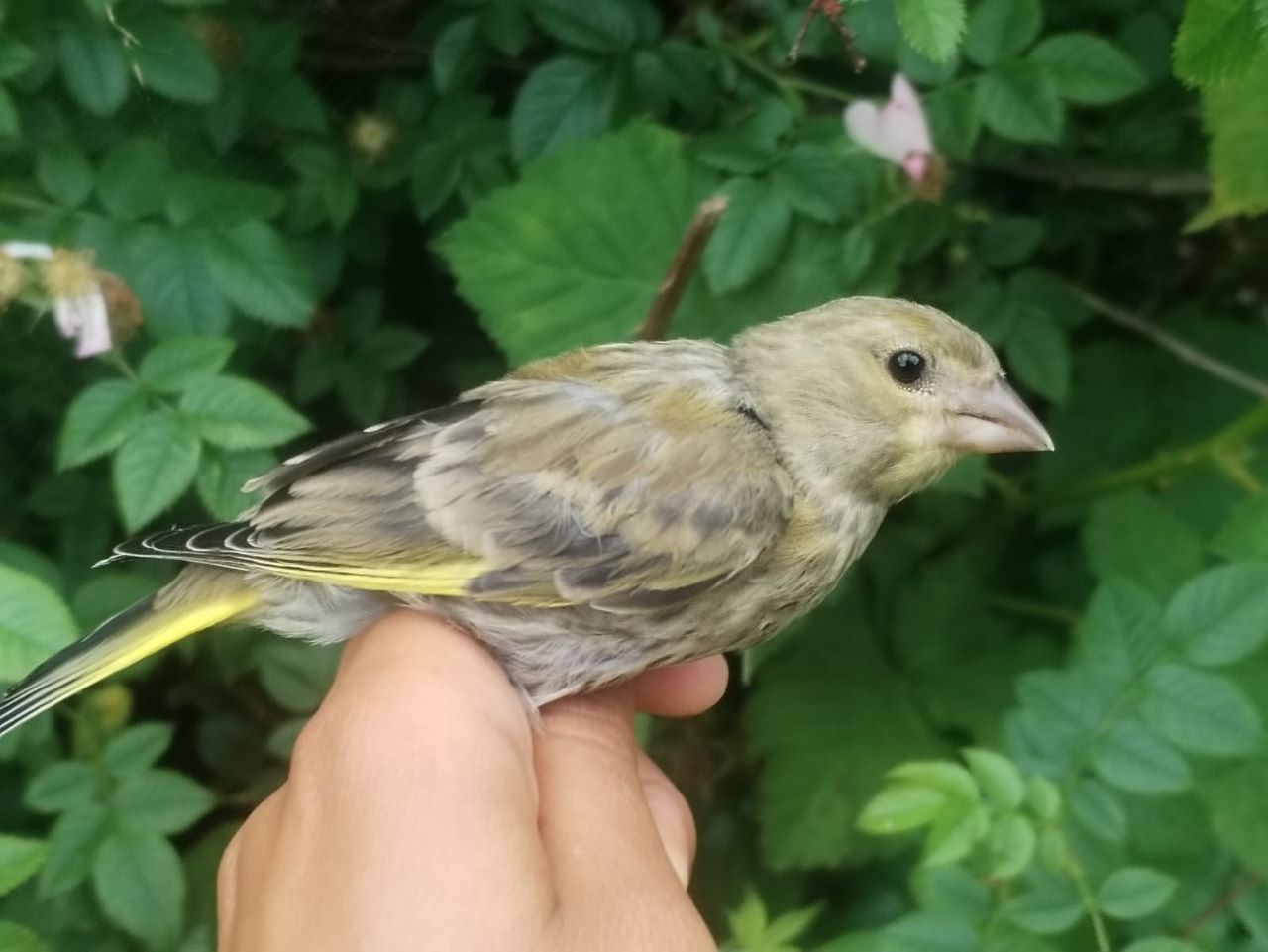
Young Greenfinch "Grønirisk"
The moths: As it was already rather warm this morning, the moth were qute flighty and some flew off, just when I opened the trap. Most of the moth I got though. It was the second time today, that I got Cerula vinula "Hermelinskåbe" in the trap, and as it is just a beatiful moth, I will put it in the blog a second time.
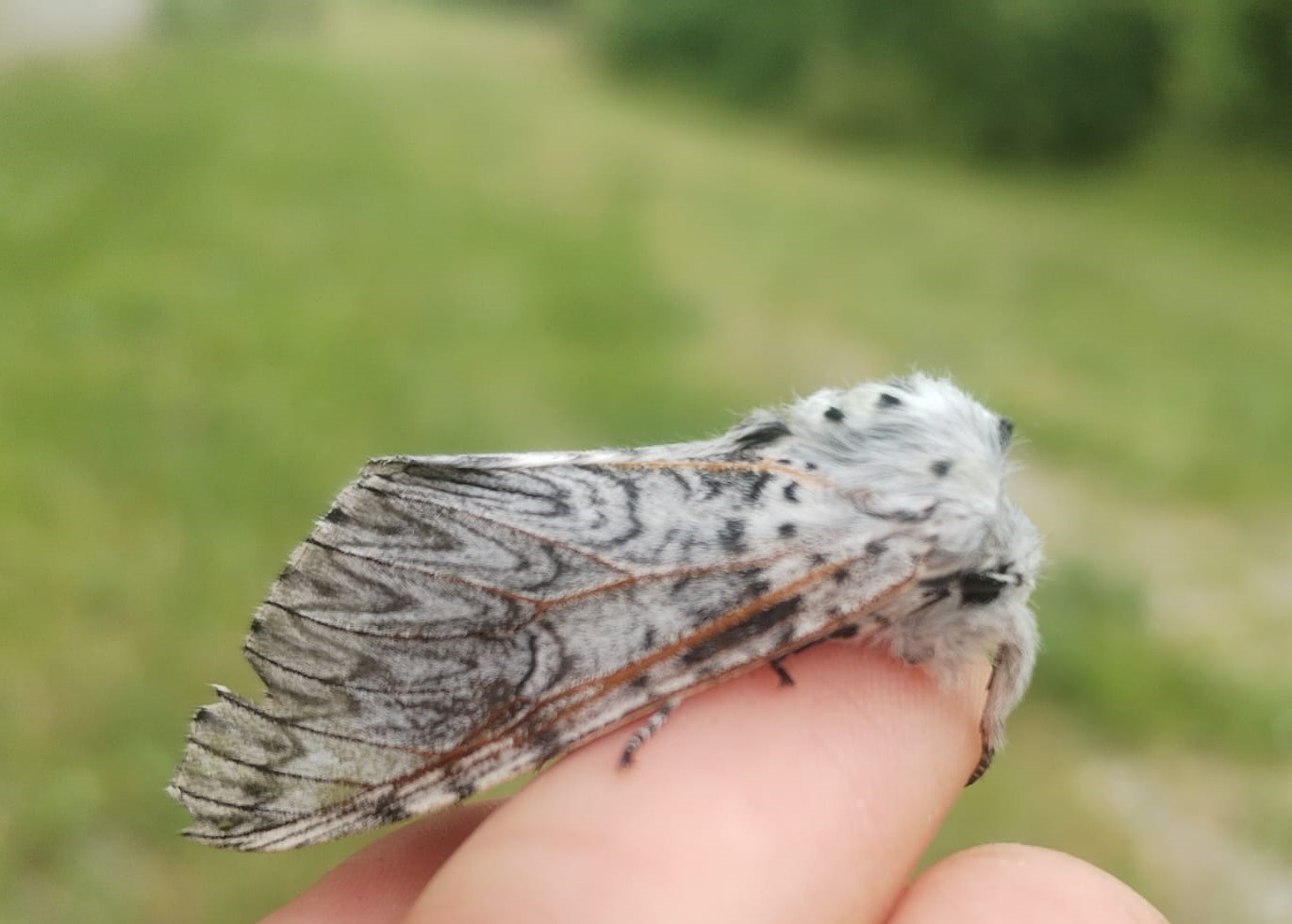
Cerula vinula "Hermelinskåbe"
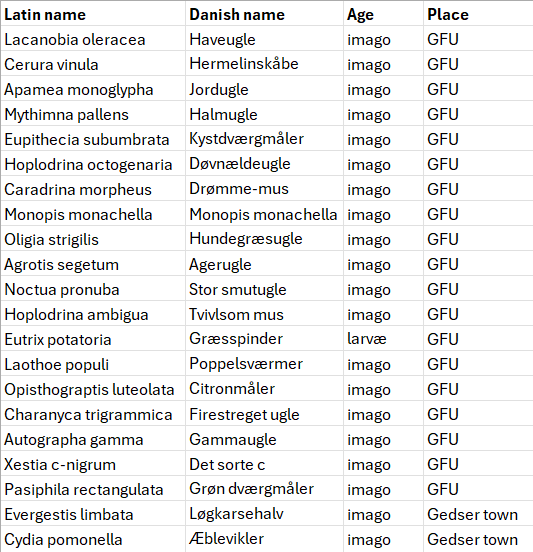
Trækket på Odden: Fredag morgen var overskuet, men lun, og vinden kom til en forandring fra nordøst. De fem standardtimer bød på en overraskelse og et lidt uventet træk. Der er altid et eller andet at komme efter på hele Nordens sydspids.
Trækket af Ederfugle (Somateria mollissima) fortsatte med 935, der alle var hanner. På tre dage er der i standardtiden registreret 3.611 Ederfugle, som stort set kun har været hanner, idet der kun har været 20 hunner med i trækket. Alene antallet er selvfølgelig interessant med 1.200 hanner af Ederfugle i dagligt gennemsnit på ’efterårstræk’ i juni. Det er sådan noget, der gør det til et spændende privilegium at arbejde med de mest almindelige fugle. Vi registrerer trafikken af fugle – og overlader det til forskere at finde ud af, hvorfor trafikken er, som den er i en tid med klimaforandringer, mangel på insekter og for Ederfuglene måske mangel på andre former for mad i en forurenet Østersø, som får dem til at søge mod bedre lokaliteter på et tidligt fældningstræk.
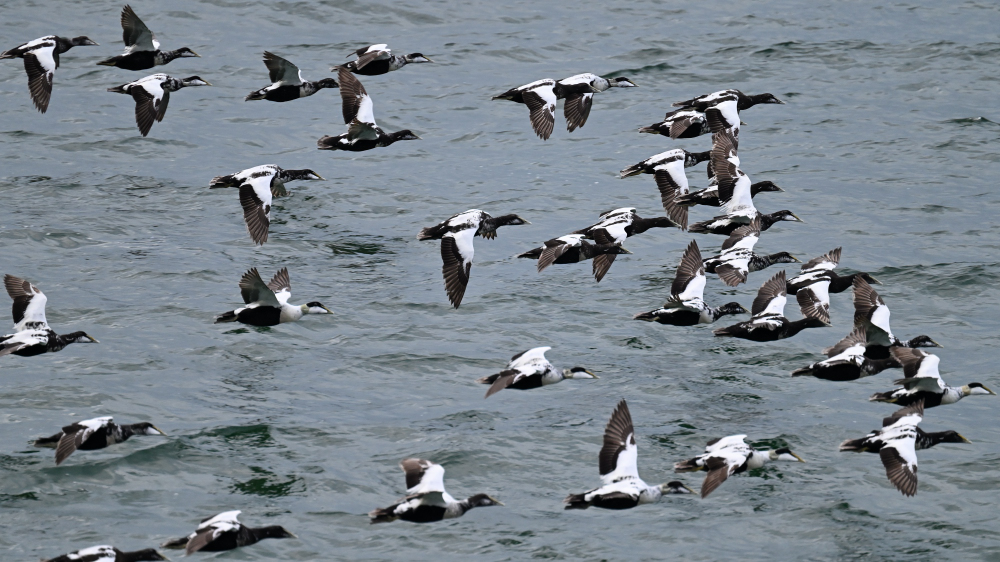
Et pænt træk af Sortænder (Melanitta nigra) var nyt for de seneste tre dages tællinger, men ikke så overraskende, for vores kolleger ved Põõsaspea neem i Estland 800 kilometer øst for Gedser Odde registrerede torsdag 236 Sortænder på sydvestgående træk, men fredagens tal på 614 ved sydspidsen var til gengæld uventet stort.
Sjovt var det også med et lille træk af Krikænder (Anas crecca) på 14 fugle, som både kom i en fin lille samlet flok og hver for sig i dagens flokke af Ederfugle.
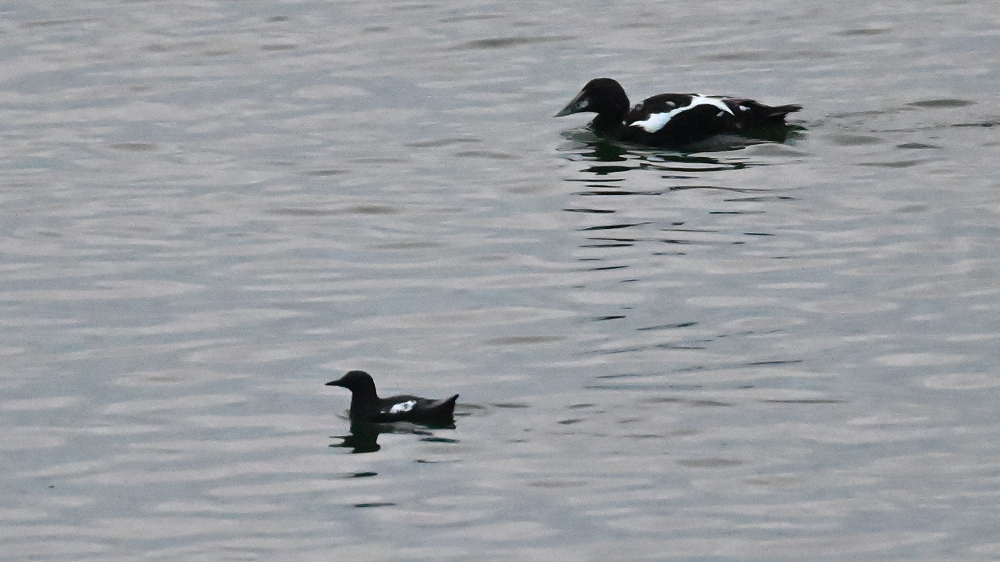
Endelig var der en Tejst (Cepphus grylle) i fuld sommerdragt, som ankom lige omkring solopgang og stadig dykkede ivrigt efter mad ved Gedser Rev, da standardtiden sluttede. På et tidspunkt var der også en voksen/adult Sule (Morus bassanus), som jagtede tæt på land over revet i nogle minutter, før den forsvandt mod vest.
Det har været tre interessante dage med få arter, men alligevel fint havtræk. Selv om tællingerne er foregået efter fuglestationens standardregler har de været spontane og uden for de sæsoner, hvor vi organiserer standardtællinger. Derfor kan de ses som en stikprøve til inspiration, men er også forbi nu. Tak for denne omgang.
Se alle dagens observationer fra Gedser Odde i DOFbasen.
Folk på stationen: Hanelie Sidhu, Jasper Mosman, Henrik Jørgensen & Ole Friis Larsen.
